Swallows are a group of passerine birds that are found worldwide, including in many different habitats.
They have evolved to be highly adapted to living in the air, and many species are renowned for their aerial acrobatics and swiftness.
Swallows are highly social animals, often nesting in colonies and gathering in large flocks. They are known for their distinctive forked tails and long pointed wings, and their diets typically consist of flying insects.
Swallows are a vital part of many ecosystems and can be important indicators of environmental health.
1. Barn Swallow
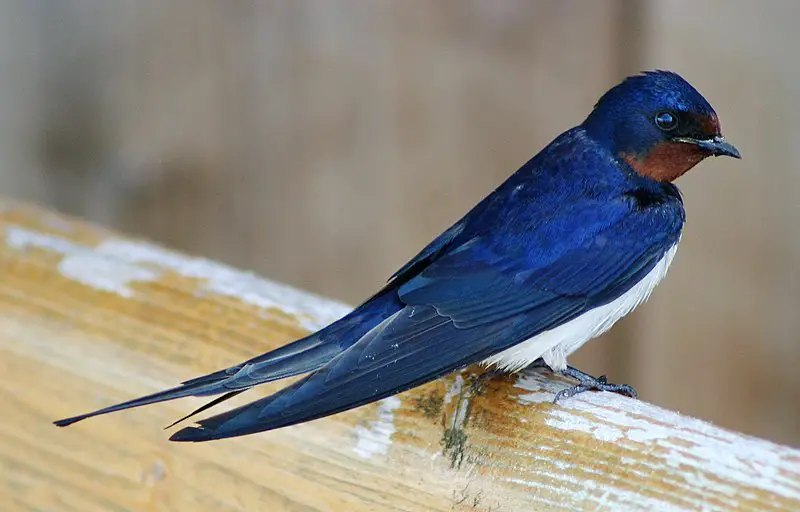
The Barn Swallow is a beautiful passerine bird with blue upperparts and a long, deeply forked tail. Found in Europe, Asia, Africa and the Americas.
It has an astonishingly large natural distribution spanning 251 million square kilometres globally; likely making it one of the world’s most widespread species.
This swallow typically nests near human habitation as well as other open areas such as fields or grasslands which provide them with suitable invertebrate prey to feed on.
They are insectivorous birds that often fly together in flocks looking for food over rivers or marshes usually just above tree-top level.
The barn swallow can also be identified by its strong flight consisting of swift continuous wing beats interspersed with glides during which they hold their wings slightly raised at the shoulders giving them distinct V shaped silhouettes in the sky.Scientific classification:
| Kingdom | Animalia |
| Phylum | Chordata |
| Class | Aves |
| Order | Passeriformes |
| Family | Hirundinidae |
| Genus | Hirundo |
| Species | H. rustica |
2. Tree Swallow
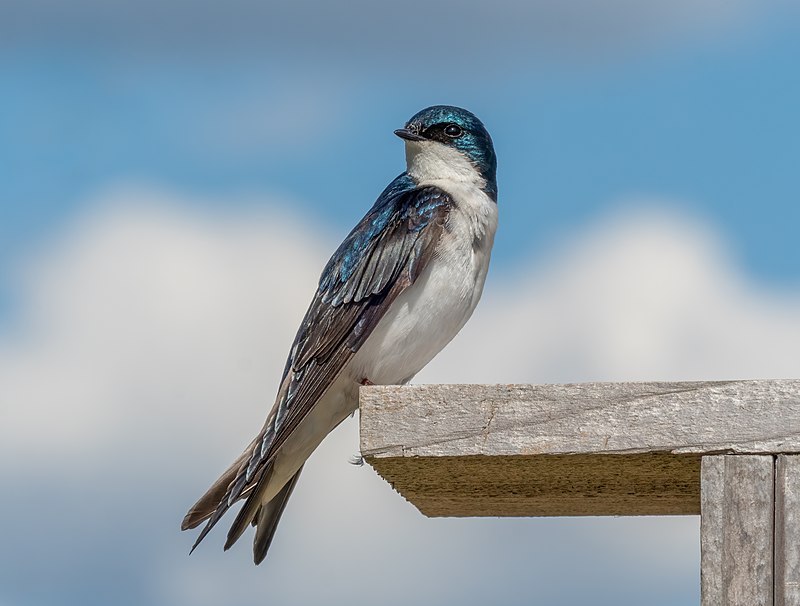
The Tree Swallow is a migratory bird of the Hirundinidae family, first described by French ornithologist Louis Vieillot in 1807. It has glossy blue-green upperparts, and white underparts with iridescent violet on its throat and breast.
Its wings are blackish above with pale grey below, while its tail feathers are blackish-blue with white edges.
During breeding season they build cup shaped nests out of grasses or twigs which are lined with animal hair or fur found near their nesting sites.
They feed mainly on insects such as flies and beetles that they catch while flying over fields or water surfaces during summer months when food is abundant for them to survive migration back southward in winter time.
The tree swallow is an important part of our environment both aesthetically and ecologically due to it’s insectivorous diet helping keep pest populations low in certain areas where agricultural crops may otherwise be damaged without these birds around.Scientific classification:
| Kingdom | Animalia |
| Phylum | Chordata |
| Class | Aves |
| Order | Passeriformes |
| Family | Hirundinidae |
| Genus | Tachycineta |
| Species | T. bicolor |
Also Featured In: Blue Birds You’ll Found around Us, House Birds You’ll Love to Pet
3. Cliff Swallow
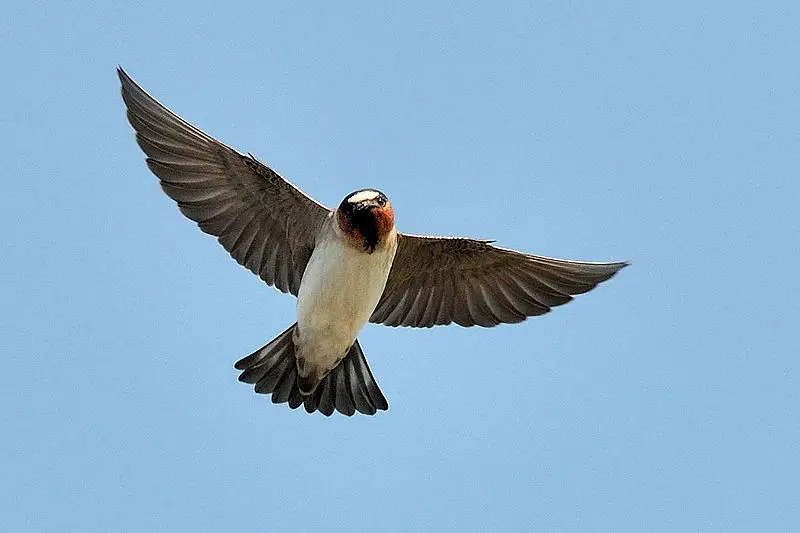
The Cliff swallow, or American cliff swallow (Petrochelidon pyrrhonota) is a species of passerine bird belonging to the family Hirundinidae. They are commonly found in North and South America.
These birds have an unmistakable appearance with their bright orange foreheads and flame-coloured backs that make them stand out from other swallows.
Cliff swallows form large colonies when nesting on cliffsides which makes them very social creatures; they often feed together while flying around fields or rivers looking for insects to eat.
In addition, they use mud pellets to build cup-shaped nests under bridges and eaves of buildings near water sources such as lakes, rivers and marshes – usually close by human dwellings.
Overall, these fascinating birds are both beautiful to look at yet practical too — providing insect pest control services through feeding on flies and mosquitoes in return for humans’ protection – what could be better?Scientific classification:
| Kingdom | Animalia |
| Phylum | Chordata |
| Class | Aves |
| Order | Passeriformes |
| Family | Hirundinidae |
| Genus | Petrochelidon |
| Species | P. pyrrhonota |
Also Featured In: Birds Live Near San Diego, Birds that Live in San Francisco Bay Area
4. Violet-Green Swallow
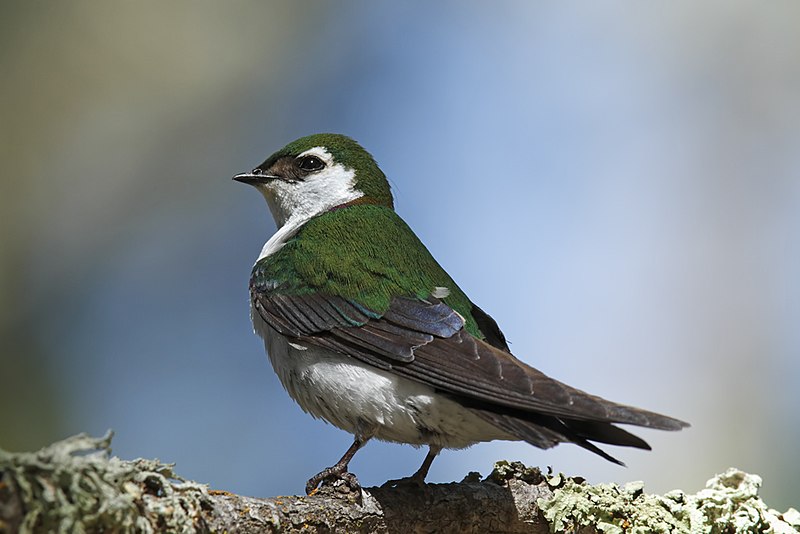
The Violet-green Swallow is a small, North American passerine bird belonging to the swallow family.
These birds are known for their aerial insectivorous diet and beautiful green coloration with white rump side patches that appear as if they’re separating it from other swallows.
They inhabit areas along the west coast of America, ranging from Alaska all the way down to Mexico and also extending eastwards to Montana and Texas.
This species can be seen swooping through open air in search of food or heard chirping away during its mating season – usually occurring between April till late summer months.
It’s an important part of many ecosystems due to its role in controlling insects populations.Scientific classification:
| Kingdom | Animalia |
| Phylum | Chordata |
| Class | Aves |
| Order | Passeriformes |
| Family | Hirundinidae |
| Genus | Tachycineta |
| Species | T. thalassina |
Also Featured In: Birds in Pacific Northwest, Small Birds of Texas
5. Sand Martin
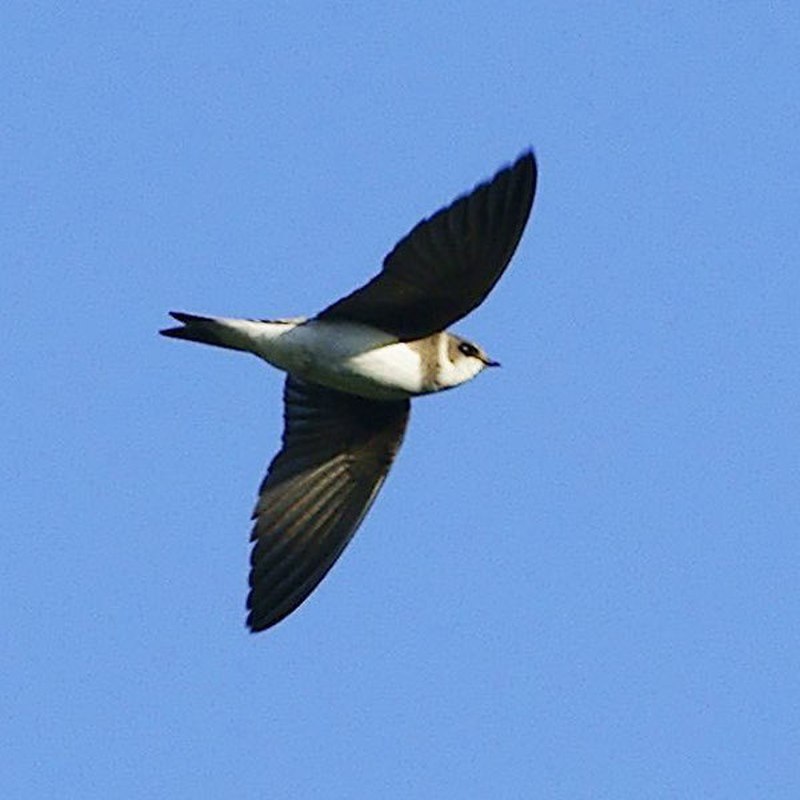
The sand martin, also known as the bank swallow or collared sand martin, is a migratory bird belonging to the swallow family.
It has an extensive summer range that covers most of Europe and other parts of Palearctic region such as North America.
During winter season it can be found in tropical Africa and India. The length of this small passerine bird varies from 12-14 cm with wingspan stretching up to 24 cm long.
Its back feathers are brownish grey while its belly is white in colour with dark streaks on sides.
Sand Martin feeds mainly on flying insects which they catch during their flight along rivers or over wetlands making use of their swift flight abilities at low altitudes foraging food items like flies and mosquitoes midair.Scientific classification:
| Kingdom | Animalia |
| Phylum | Chordata |
| Class | Aves |
| Order | Passeriformes |
| Family | Hirundinidae |
| Genus | Riparia |
| Species | R. riparia |
Also Featured In: Turkey Birds You Should Know, Bulgarian Birds
6. Cave Swallow
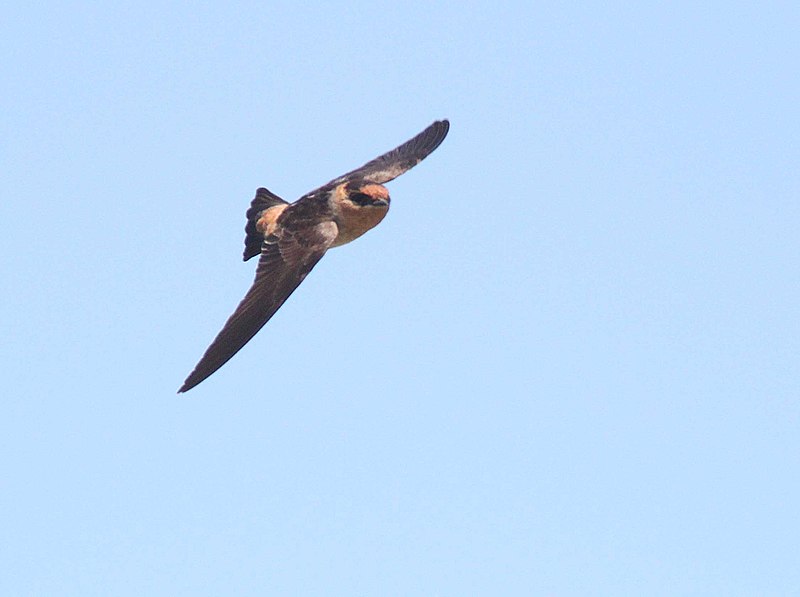
The Cave Swallow is a species of bird native to the Americas, belonging to the same genus as the more widely known Cliff Swallow.
It is medium-sized with a square tail and nests in caves and sinkholes rather than typical nesting spots like trees or buildings.
This beautiful swallow can be found in Mexico and Greater Antilles, but has been known to wander north during fall/winter months reaching east coast areas along with Gulf Coasts.
These birds are interesting due their habit of exclusively using natural cavities for protection while they breed, making them unique compared to other swallows who rely on man-made structures such as barns or bridges.
The Cave Swallow is an important part of its environment that should be preserved so future generations can appreciate its beauty.Scientific classification:
| Kingdom | Animalia |
| Phylum | Chordata |
| Class | Aves |
| Order | Passeriformes |
| Family | Hirundinidae |
| Genus | Petrochelidon |
| Species | P. fulva |
Also Featured In: Birds that Make Mud Nests, Birds You’ll Find in the Rio Grande Valley
7. Northern Rough-Winged Swallow
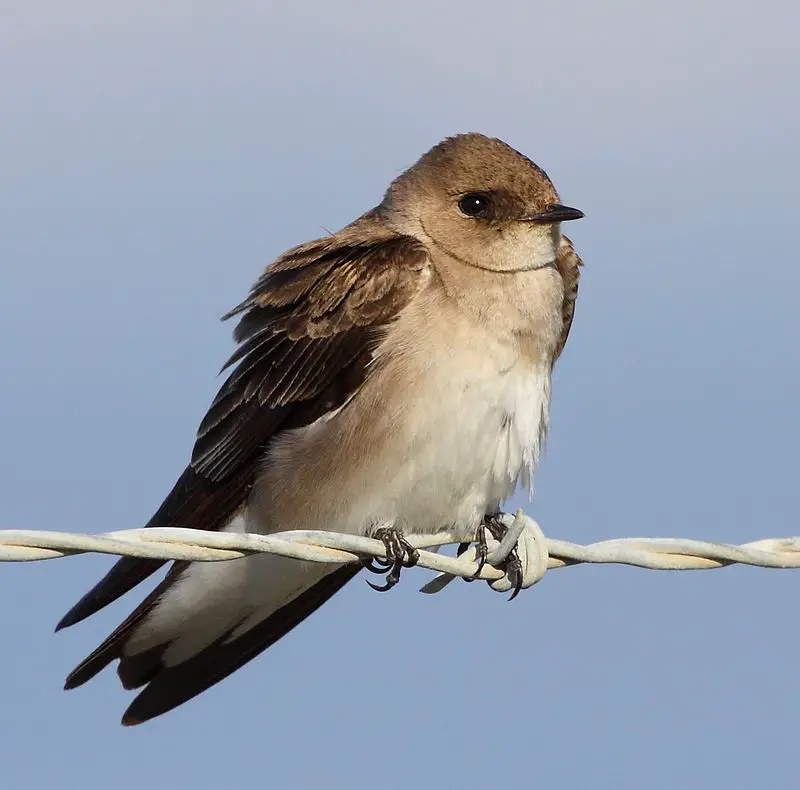
The Northern Rough-winged Swallow is a small migratory bird belonging to the genus Stelgidopteryx.
It is easily identifiable by its “scraper wing” and serrated feathers, giving it the common name of rough-winged swallow.
These birds are found in North America during summer months, migrating south for winter.
They have brown upperparts with a white belly and greyish wings which show darker markings near their tips when seen from below.
Their diet consists mainly of insects such as flies, beetles and wasps captured on the wing while flying low over grassy areas or water bodies like ponds or lakes.
As they migrate long distances each year between their breeding grounds in North America and their wintering sites further southwards, these swallows rely heavily on thermals created by warm air rising up from ground level to help them soar high into the sky with minimal effort.Scientific classification:
| Kingdom | Animalia |
| Phylum | Chordata |
| Class | Aves |
| Order | Passeriformes |
| Family | Hirundinidae |
| Genus | Stelgidopteryx |
| Species | S. serripennis |
Also Featured In: Birds that Live around Santiago de Querétaro,
8. Purple Martin
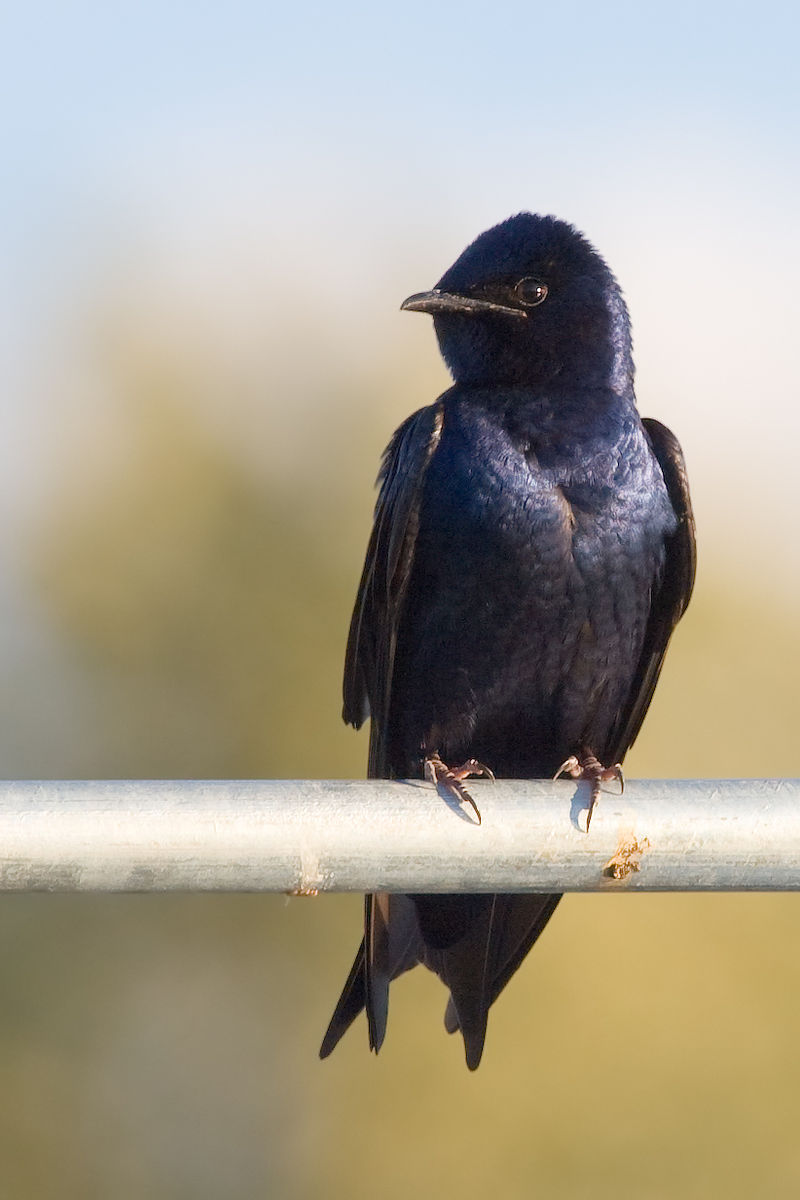
The Purple Martin is a beautiful passerine bird in the swallow family, and is the largest of its kind in North America.
It has dark blackish-blue feathers that have an iridescent sheen which can make them appear blue or deep purple depending on the light; they may even look green.
These birds are quite social creatures and often build communal roosts with multiple nests, having as many as hundreds of individuals living together at once.
They feed mainly on flying insects such as flies, moths, wasps and bees.
Their habitats include areas near bodies of water like lakes or rivers where there’s plenty for these birds to eat all year round.
The Purple Martin is truly an amazing species worth protecting.Scientific classification:
| Kingdom | Animalia |
| Phylum | Chordata |
| Class | Aves |
| Order | Passeriformes |
| Family | Hirundinidae |
| Genus | Progne |
| Species | P. subis |
Also Featured In: Birds That Live in Colorado, Magenta Birds You Didn’t Know
9. Blue Swallow
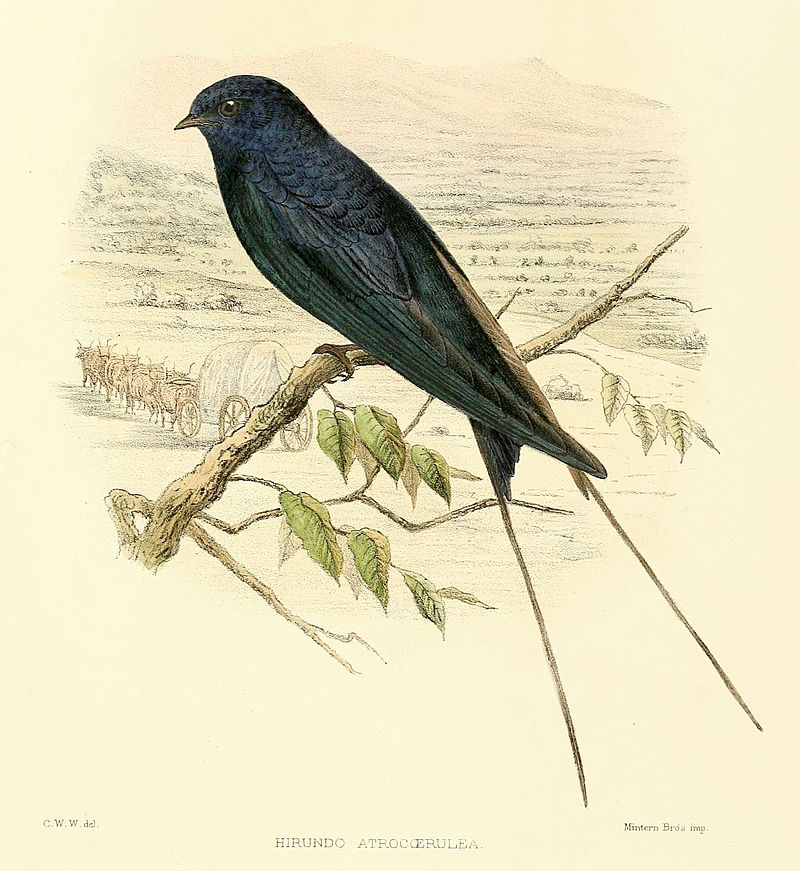
The Blue Swallow is a small bird from the swallow family and order Passeriformes. It has distinctive blue plumage on its back, wings and tail that makes it stand out among other aerial insectivores such as martins or swifts.
The species breeds in the Afromontane region ranging from South Africa to Tanzania, before migrating north of Lake Victoria during wintertime.
Their preferred habitat includes mountainous regions with an abundance of insects for them to feed upon; they form colonies which can range between 2-6 pairs per site depending on local conditions.
They are remarkably agile flyers who spend most of their days hunting high up in the sky – making them both unique and captivating birds.Scientific classification:
| Kingdom | Animalia |
| Phylum | Chordata |
| Class | Aves |
| Order | Passeriformes |
| Family | Hirundinidae |
| Genus | Hirundo |
| Species | H. atrocaerulea |
10. Chimney Swift
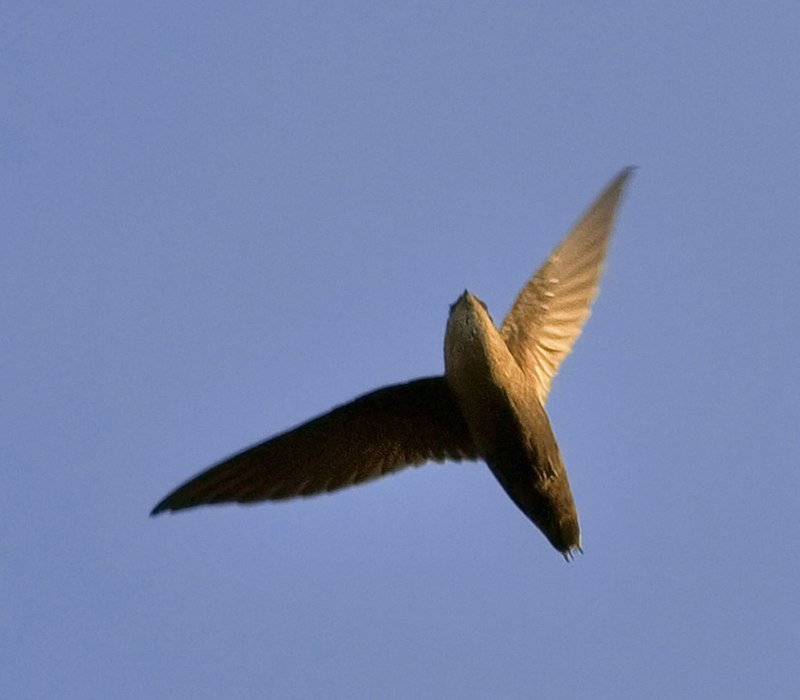
The Chimney Swift is a bird that belongs to the swift family Apodidae. It has no subspecies and is closely related to both Vaux’s swift and Chapman’s Swift.
This sooty gray bird with very long, slender wings stands out from other swifts in its genus due to its short legs.
They are found all over North America, but migrate south during winter months for more temperate climates.
These agile birds spend most of their lives on the wing while they feed on aerial insects such as flies and moths using their curved beaks which were specifically adapted by evolution for this purpose.
Their nests consist of twigs glued together with saliva secreted by glands located near their mouths, usually built inside chimneys or hollow trees making them an important species for pest control.Scientific classification:
| Kingdom | Animalia |
| Phylum | Chordata |
| Class | Aves |
| Order | Apodiformes |
| Family | Apodidae |
| Genus | Chaetura |
| Species | C. pelagica |
11. Blue-And-White Swallow
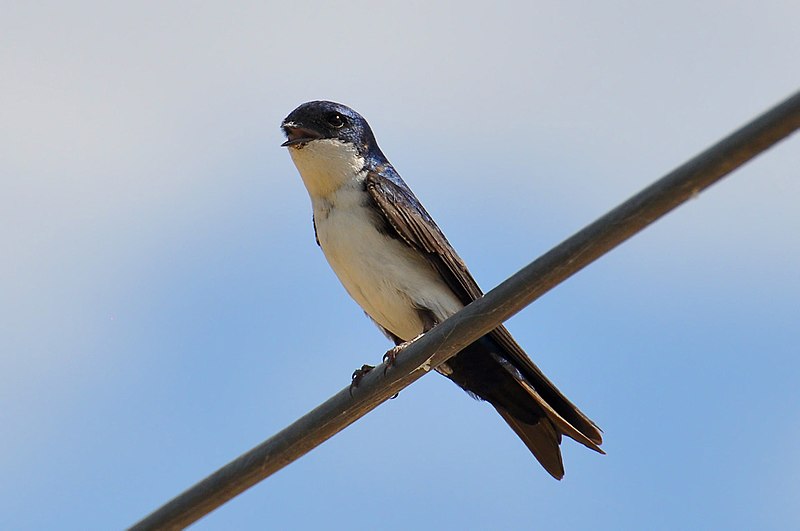
The Blue-and White Swallow is a beautiful passerine bird that can be found from Nicaragua down to South America.
It has two different races, the northern race which may have bred in Trinidad and the southern race which migrates there during wintertime.
Its scientific name is Pygochelidon cyanoleuca and it was first formally described as Hirundo by Carl Linnaeus in 1758.
This small swallow stands out for its blue upperparts with white underparts, giving it an overall distinctive look compared to other species of birds living in similar regions.
In addition, their wingspan reaches up to 20 cm making them very agile flyers capable of catching insects on the fly while they migrate throughout Central American countries looking for food sources and suitable nesting sites.Scientific classification:
| Kingdom | Animalia |
| Phylum | Chordata |
| Class | Aves |
| Order | Passeriformes |
| Family | Hirundinidae |
| Genus | Pygochelidon |
| Species | P. cyanoleuca |
12. Welcome Swallow
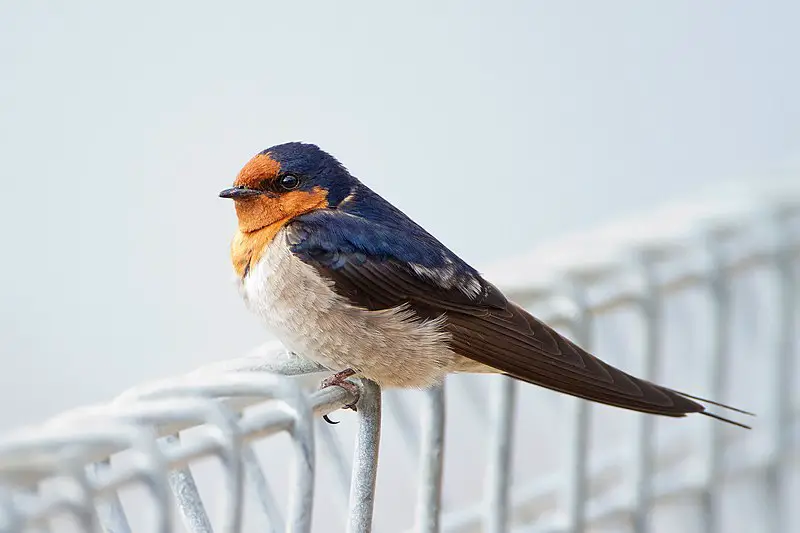
The Welcome Swallow (Hirundo neoxena) is a small passerine bird in the swallow family, native to Australia and nearby islands.
It was self-introduced into New Zealand in the mid twentieth century and is often considered conspecific with the Pacific swallow.
This species breeds mainly throughout southern and eastern Australia across various habitats such as woodlands, open countrysides, grasslands, marshes and coastal areas.
They are most commonly seen near human settlements like farmhouses or parks where they build their distinctive mud nests under eaves of buildings or on bridges.
The adults have steel-blue upperparts with pale rufous undersides while their throat has white stripes that extend down onto its breast feathers giving it a very attractive look.Scientific classification:
| Kingdom | Animalia |
| Phylum | Chordata |
| Class | Aves |
| Order | Passeriformes |
| Family | Hirundinidae |
| Genus | Hirundo |
| Species | H. neoxena |
Also Featured In: Birds that Live around Brisbane, Birds of Tasmania
13. Common House Martin
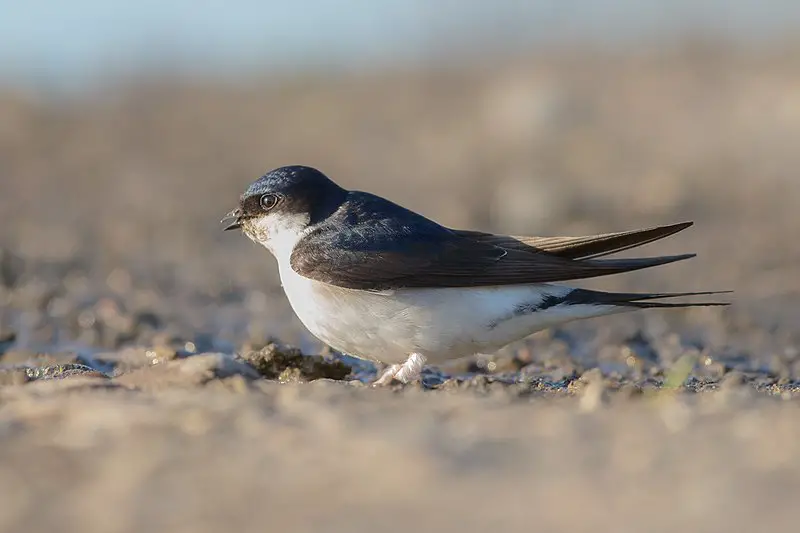
The Common House Martin is a beautiful migratory bird of the swallow family. It breeds in Europe, North Africa and across the Palearctic region, then winters in sub-Saharan Africa and tropical Asia.
This species feeds on insects caught while flying through its habitat.
Its main food source changes depending on where it is located at any given time as it follows warmer climates with more abundance of flies during winter months when migrating southward from its breeding grounds up north.
The house martin has an unmistakable appearance; they have glossy blue upperparts and white underparts that contrast beautifully against their black wingspan which can reach up to 18 cm long.Scientific classification:
| Kingdom | Animalia |
| Phylum | Chordata |
| Class | Aves |
| Order | Passeriformes |
| Family | Hirundinidae |
| Genus | Delichon |
| Species | D. urbicum |
14. Vaux’s Swift
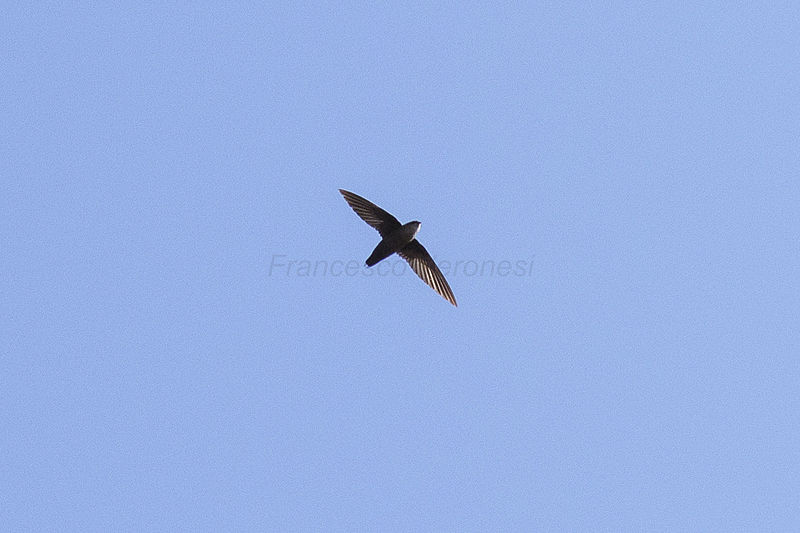
Vaux’s swift is a small bird native to North America, Central and South America. Named for the American scientist William Sansom Vaux, it measures between 10.7-11.2 cm (4.2-4.4 in) long and weighs 18 g (0.63 oz).
Northern populations are slightly larger at 11.5 cm (45 in). It has greyish brown feathers with dark stripes on its back as well as an orange throat patch which becomes more visible during flight or when singing.
Its beak is black while its legs are short and weak compared to other Chaetura species of swifts but it still manages agile flying abilities due to its wings which can reach up to 25 mph.
This species prefers nesting around old buildings such as churches or silos making them a common sight even in urbanized areas where they feed off insects like moths and flies.Scientific classification:
| Kingdom | Animalia |
| Phylum | Chordata |
| Class | Aves |
| Order | Apodiformes |
| Family | Apodidae |
| Genus | Chaetura |
| Species | C. vauxi |
15. Pacific Swallow
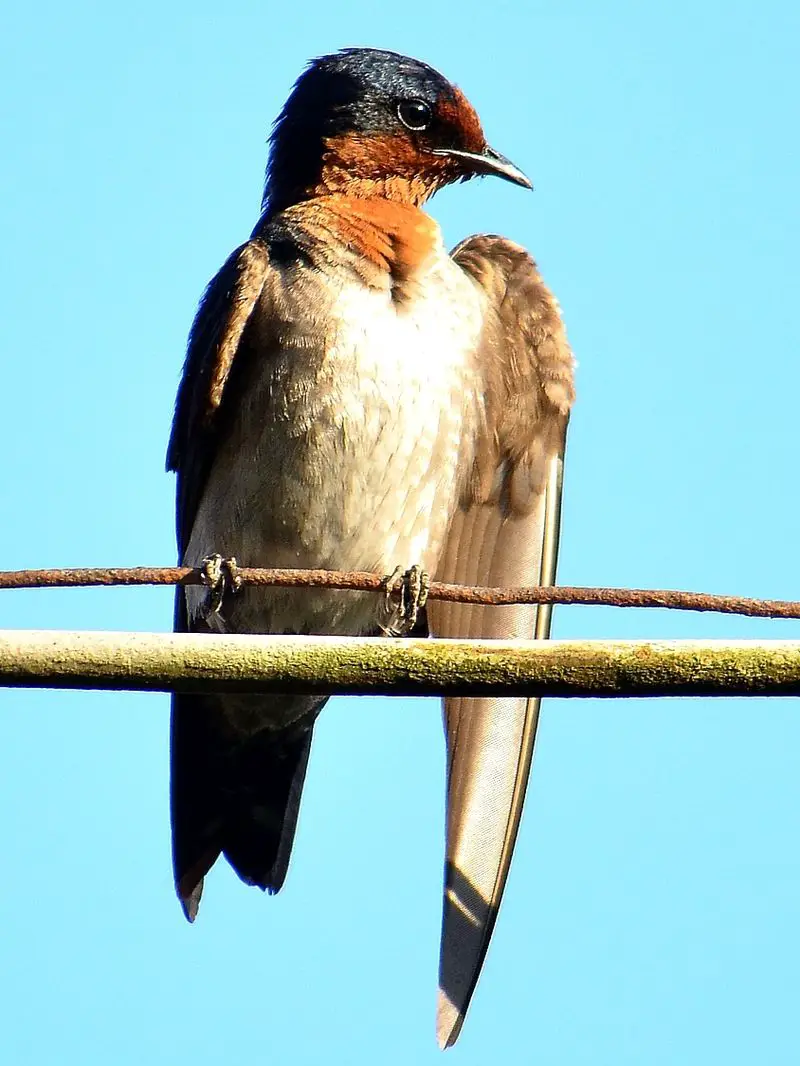
The Pacific Swallow is a small bird with glossy blue-black upperparts and white underparts. It has a short, forked tail and wings that are pointed at the tips.
This swallow typically breeds in tropical southern Asia and the islands of the south Pacific Ocean, although it is becoming more common on forested uplands away from coasts.
During breeding season they construct cup or saucer shaped nests made out of mud pellets in sheltered areas such as rock crevices, eaves or tree hollows.
The diet consists mostly of flying insects which they catch while flying low over water bodies like lakes or rivers during their migratory flights between nesting sites to feeding grounds.
They often travel together in flocks when migrating long distances but can sometimes be seen alone chasing after prey midair.Scientific classification:
| Kingdom | Animalia |
| Phylum | Chordata |
| Class | Aves |
| Order | Passeriformes |
| Family | Hirundinidae |
| Genus | Hirundo |
| Species | H. tahitica |
16. Brown-Bellied Swallow
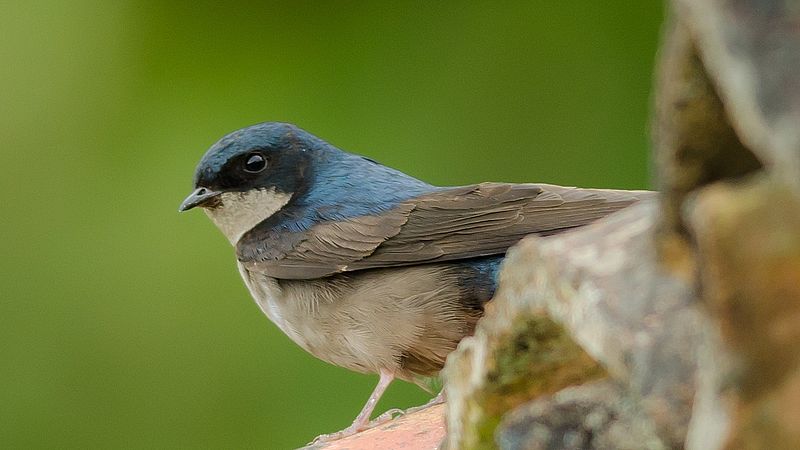
The Brown-bellied Swallow is a species of bird in the family Hirundinidae, found mainly in South America.
These birds are usually seen flying around open grasslands and pastures, as well as subtropical shrubland at higher elevations.
They have an attractive brown underside with chestnut markings on their wings and tail. The upper side is greyish white with black flight feathers and a forked swallow-like tail.
This distinctive plumage makes them stand out from other similar looking swallows such as the blue-and-white swallow which has all dark feathers on its backside instead of being lighter like that of the Brown-bellied Swallow.
These beautiful birds feed primarily on insects while they fly through their habitats during midair chases or while hovering over water sources to catch prey items using sallies after detecting movement below them with quick glances downwards.Scientific classification:
| Kingdom | Animalia |
| Phylum | Chordata |
| Class | Aves |
| Order | Passeriformes |
| Family | Hirundinidae |
| Genus | Orochelidon |
| Species | O. murina |
17. Lesser Striped Swallow
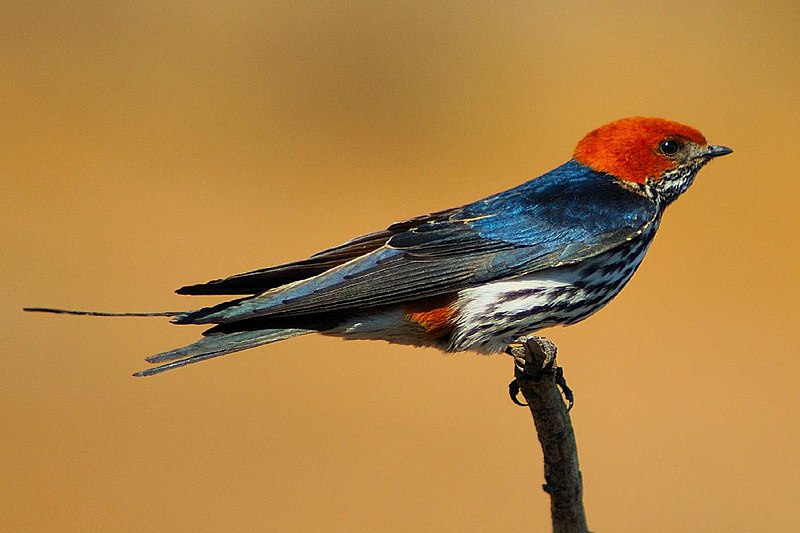
The lesser striped swallow is a large and beautiful bird native to Sub-Saharan Africa. It inhabits mainly lowland wooded areas, but some South African birds migrate further north in the winter months.
They have striking plumage of white undersides with black streaks on their wings and back as well as reddish brown chests.
The diet consists mostly of flying insects which they catch while flying over water or treetops.
Breeding season occurs during spring when pairs create mud nests under eaves or other sheltered sites near bodies of water.
Once hatched, both parents will take turns feeding the young until fledging at around 17 days old.Scientific classification:
| Kingdom | Animalia |
| Phylum | Chordata |
| Class | Aves |
| Order | Passeriformes |
| Family | Hirundinidae |
| Genus | Cecropis |
| Species | C. abyssinica |
18. Red-Chested Swallow
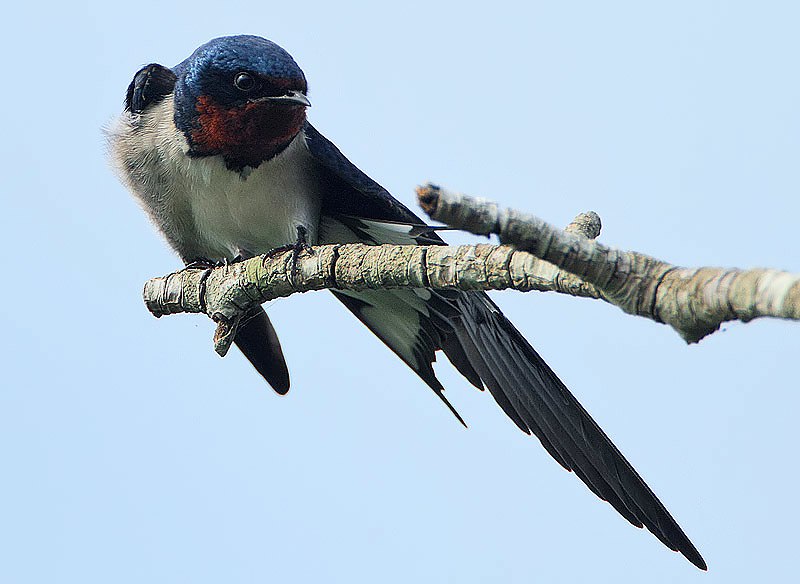
The red-chested swallow is a beautiful passerine bird native to West Africa, the Congo Basin and Ethiopia.
This species has an unmistakable appearance with its long, deeply forked tail and curved wings which give it a graceful flight pattern.
Its chest is primarily reddish in color while it head and body are mostly dark brown or black. It slightly smaller than the barn swallow but otherwise looks very similar.
The red-chested swallows live in open woodlands near streams where they hunt insects on the wing during daytime hours before returning to roosts at nightfall.
These birds mate for life though some will form large colonies during breeding season so that several pairs can breed together simultaneously.
They build their nests of mud under ledges such as bridges or cliffs, creating cup shaped homes lined with grasses and feathers for protection against predators like snakes or cats looking for eggs.Scientific classification:
| Kingdom | Animalia |
| Phylum | Chordata |
| Class | Aves |
| Order | Passeriformes |
| Family | Hirundinidae |
| Genus | Hirundo |
| Species | H. lucida |
19. Mangrove Swallow
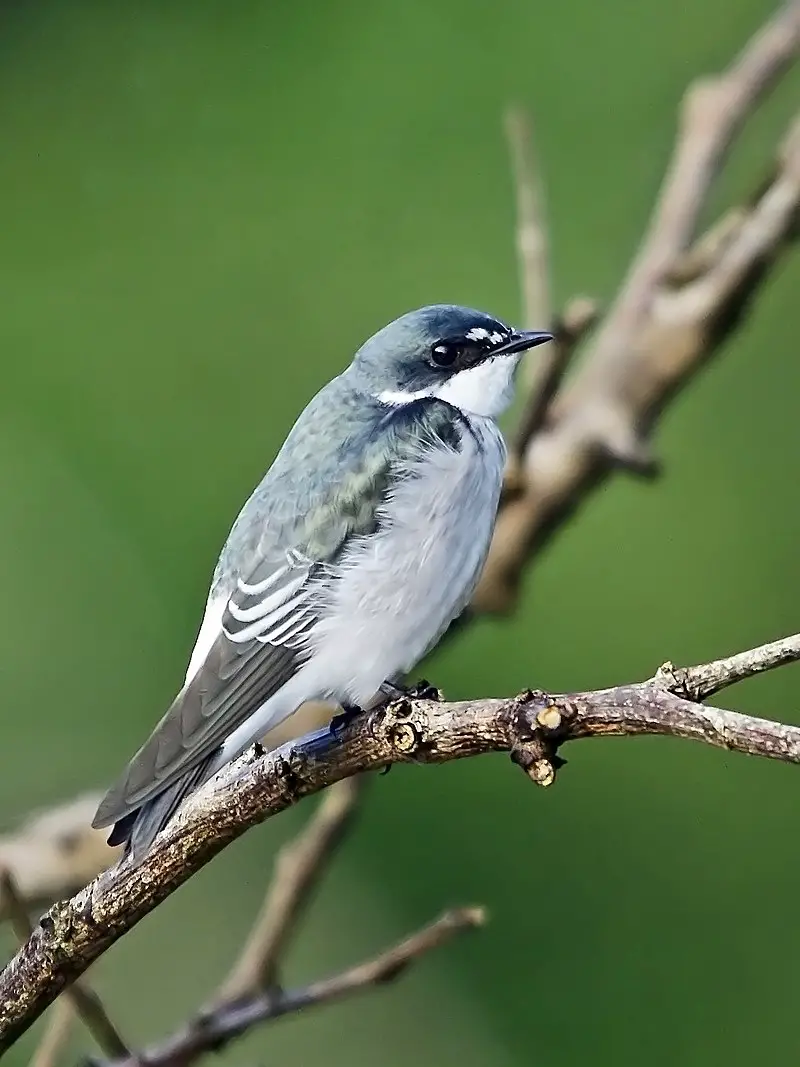
The Mangrove Swallow is a gorgeous bird that can be seen along coasts from Mexico to Panama.
It has bright blue-green upperparts, blackish flight feathers and a white rump, with the standout feature being its supraloral white streak – a line near its eye which only occurs in two other species of Tachycineta.
This swallow is often found flying around mangroves where it feeds on insects such as flies, wasps and beetles during the day and perches for roosting at night.
They nest in colonies close to each other under eaves or overhangs of buildings and tree hollows lined with mud pellets they create themselves.
The Mangrove Swallow makes an important contribution to our ecosystems by providing natural pest control services while adding beauty to coastal areas throughout Central America.Scientific classification:
| Kingdom | Animalia |
| Phylum | Chordata |
| Class | Aves |
| Order | Passeriformes |
| Family | Hirundinidae |
| Genus | Tachycineta |
| Species | T. albilinea |
20. White-Backed Swallow
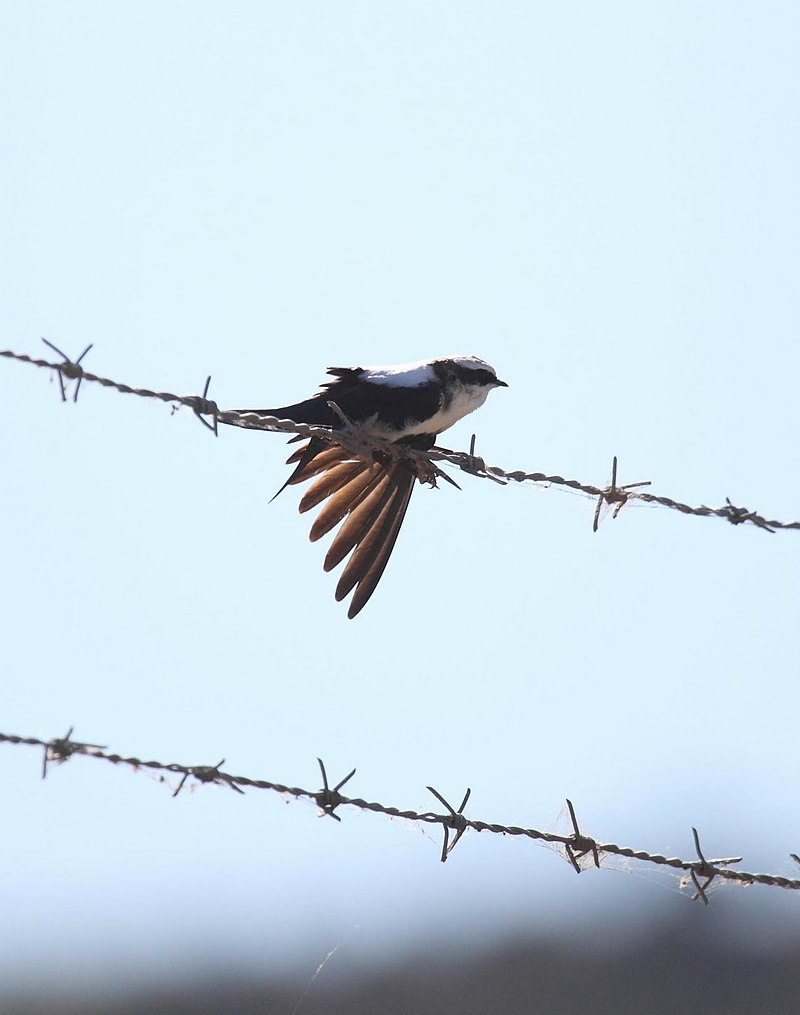
The White-backed Swallow is a species of bird belonging to the Hirundinidae family, only found in Australia. It has an easily recognizable look with its white back and black wings and tail.
This swallow is adapted for aerial feeding; it hunts on the wing catching small insects as it flies around.
They usually live in open habitats such as grasslands, woodlands or even near water bodies like lakes and rivers where they can find food more easily.
Its diet consists mainly of flying insects like midges, mosquitoes or moths which they catch while soaring through the air at high speeds up to 40km/h.
The White-backed Swallow breeds between August to December laying 3–4 eggs each time that hatch after 16 days incubation period by both parents taking turns sitting on them throughout this time.Scientific classification:
| Kingdom | Animalia |
| Phylum | Chordata |
| Class | Aves |
| Order | Passeriformes |
| Family | Hirundinidae |
| Genus | Cheramoeca Cabanis, 1850 |
| Species | C. leucosterna |
21. Black-And-Rufous Swallow
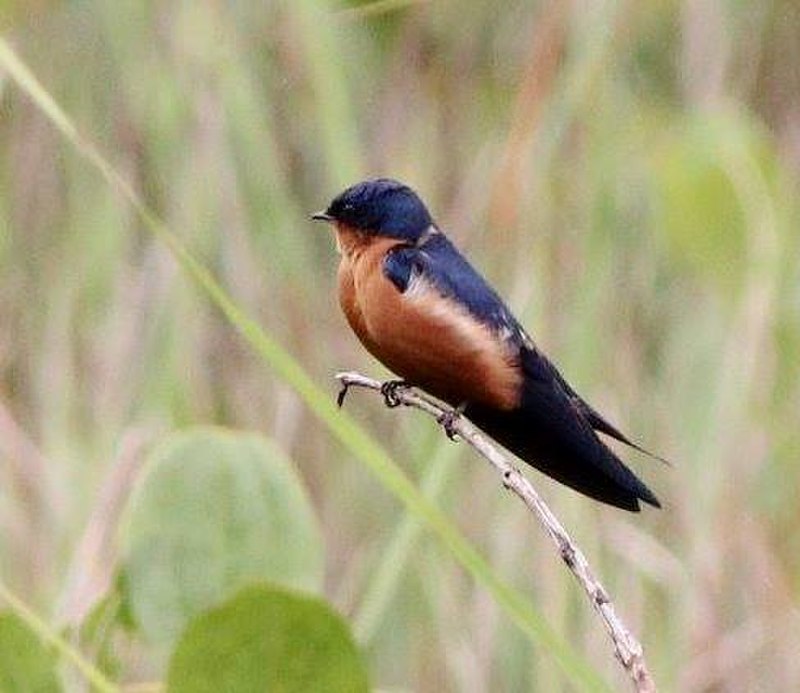
The black-and-rufous swallow is a species of bird in the Hirundinidae family. It can be found inhabiting miombo ecosystems in Angola, Democratic Republic of Congo and Zambia.
This small but beautiful creature has an unmistakable colouration – rufous on its back with glossy black wings and tail feathers that shimmer like oil when it catches light from the sun.
Its diet consists mainly of flying insects which it captures midair during its high speed flights over open country or woodland habitats.
It nests among rocks as well as tree hollows, laying up to 3 eggs at a time before incubating them for about two weeks until they hatch into fluffy chicks ready to explore their new world.Scientific classification:
| Kingdom | Animalia |
| Phylum | Chordata |
| Class | Aves |
| Order | Passeriformes |
| Family | Hirundinidae |
| Genus | Hirundo |
| Species | H. nigrorufa |
22. Red-Breasted Swallow
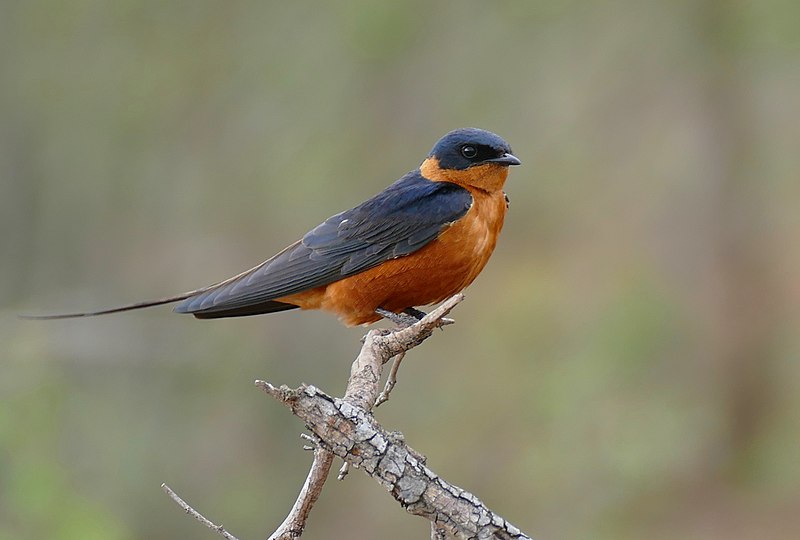
The red-breasted swallow is a species of bird belonging to the Hirundinidae family and native to Sub-Saharan Africa.
It can be distinguished from other swallows by its blue crown and mantle, contrasting with its rufous chest.
The tail streamers are longer than those found in mosque swallows, another similar species. During wet seasons it inhabits tropical rainforests exclusively but will migrate elsewhere during dry periods when food sources become scarce.
This small yet beautiful swallow feeds mainly on insects which it catches while flying at high speeds through forests or open country areas.
Its call is distinctive too – a series of squeaky chirps usually given in flight as it soars gracefully across the sky.Scientific classification:
| Kingdom | Animalia |
| Phylum | Chordata |
| Class | Aves |
| Order | Passeriformes |
| Family | Hirundinidae |
| Genus | Cecropis |
| Species | C. semirufa |
23. Congo Martin
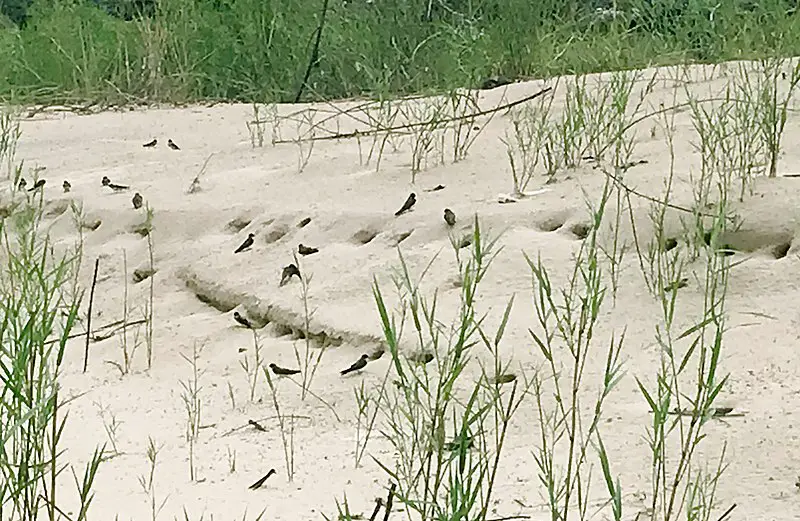
The Congo martin is a small passerine bird belonging to the swallow family. It is found only in limited areas along the Congo River and its tributary, the Ubangi.
This non-migratory species resides in forested rivers with sandbanks for breeding and can be seen fairly abundant within its range during February and March when they form colonies for nesting.
They feed on insects flying over water bodies such as lakes and wetlands or even high up in sky while taking short flights after prey items.
The conservation status of this species has not yet been evaluated by IUCN but their population trend indicates that it may soon need protection from extinction threats like habitat destruction due to human activity amongst others.Scientific classification:
| Kingdom | Animalia |
| Phylum | Chordata |
| Class | Aves |
| Order | Passeriformes |
| Family | Hirundinidae |
| Genus | Riparia |
| Species | R. congica |
24. Greater Striped Swallow
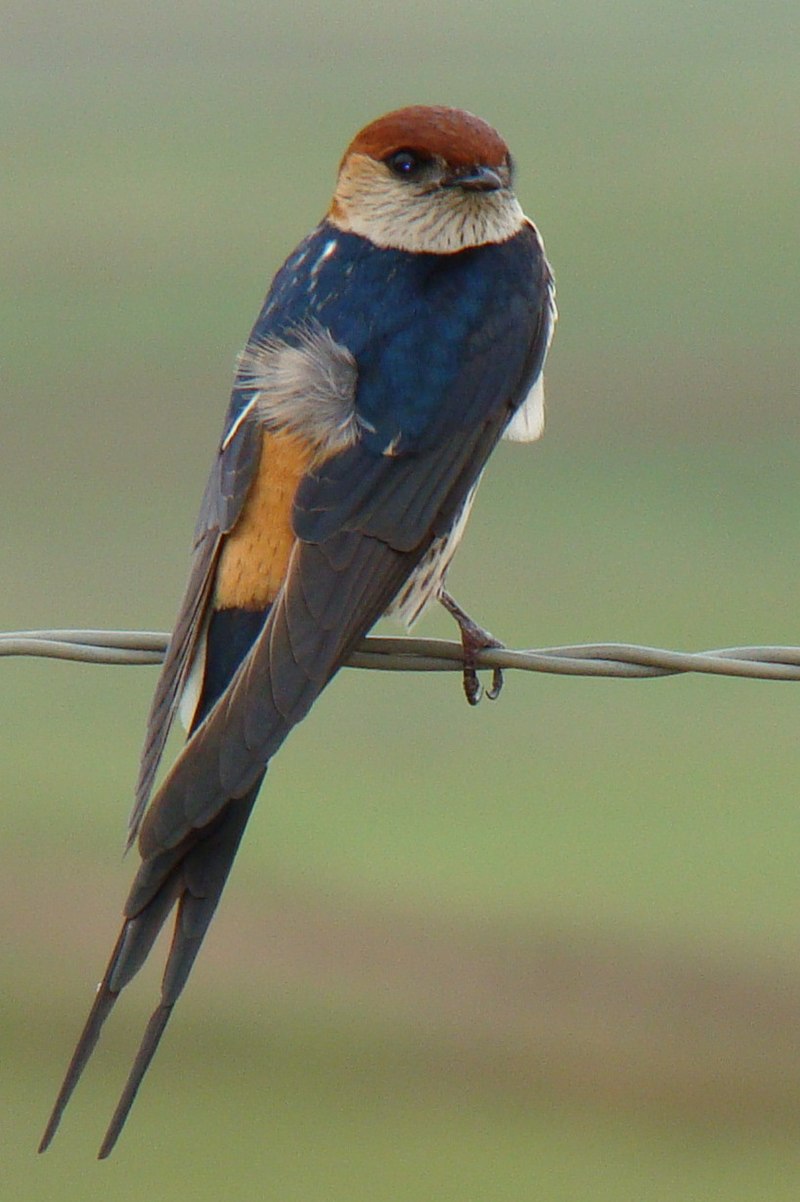
The Greater Striped Swallow is a large swallow native to Africa south of the equator. It was first described in 1780 by French polymath Georges-Louis Leclerc, Comte de Buffon and illustrated with a hand-coloured plate in his Histoire Naturelle des Oiseaux.
This colourful bird has an iridescent black head and back, white underparts, chestnut wings and tail feathers that are tipped with white bands.
They can be found near streams or open areas where they build cup nests from mud pellets mixed with grass lined inside with softer materials such as wool or fur for comfort.
These birds feed on insects which they catch midair while flying rapidly above fields or water bodies during the day.
The Greater Striped Swallow’s call is a loud ”churr churr” sound repeated several times which helps them communicate between flocks when gathering at roosting sites at nightfallScientific classification:
| Kingdom | Animalia |
| Phylum | Chordata |
| Class | Aves |
| Order | Passeriformes |
| Family | Hirundinidae |
| Genus | Cecropis |
| Species | C. cucullata |
25. White-Tailed Swallow
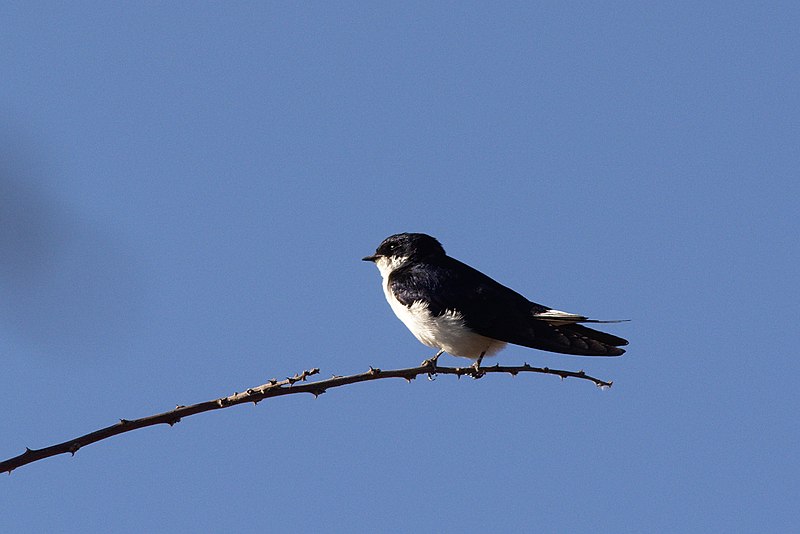
The White-tailed Swallow is a small bird belonging to the Hirundinidae family, native to Oromia in Ethiopia. It was named after ornithologist Constatine Walter Benson who first identified it.
The species has been classified as vulnerable by IUCN due to its decreasing population size and range loss caused mainly by human activities such as deforestation and agriculture expansion.
To protect this beautiful creature, conservation measures must be implemented in order for it not only survive but also thrive once again in its natural habitat.Scientific classification:
| Kingdom | Animalia |
| Phylum | Chordata |
| Class | Aves |
| Order | Passeriformes |
| Family | Hirundinidae |
| Genus | Hirundo |
| Species | H. megaensis |
26. Pied-Winged Swallow
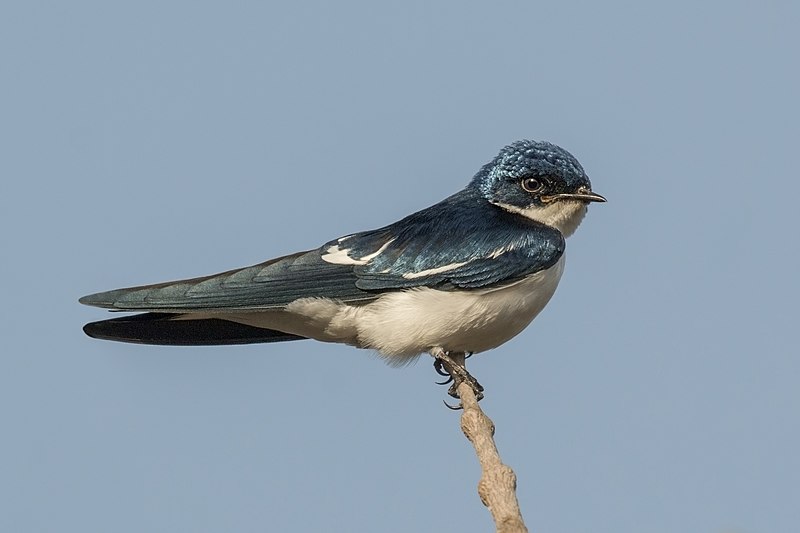
The Pied-winged Swallow is a species of bird found in parts of West Africa. It has distinctive steel-blue upperparts, with white wing patches that makes it easily distinguishable from other birds.
The binomial name Hirundo leucosoma was given to the swallow by English ornithologist William Swainson in 1837, combining Ancient Greek words for ‘swallow’ and ‘white body’ respectively.
This species can be observed flying close to the ground seeking food such as insects or small animals like frogs and lizards on open grasslands throughout its range.
A monogamous nester, they build cup shaped nests out of mud near water sources or human habitation where they lay up to three eggs at a time.
The Pied-winged Swallows are considered least concern by IUCN Red List due their large population size which currently stands at around 2 million individuals across sub Saharan Africa.Scientific classification:
| Kingdom | Animalia |
| Phylum | Chordata |
| Class | Aves |
| Order | Passeriformes |
| Family | Hirundinidae |
| Genus | Hirundo |
| Species | H. leucosoma |
27. South African Cliff Swallow
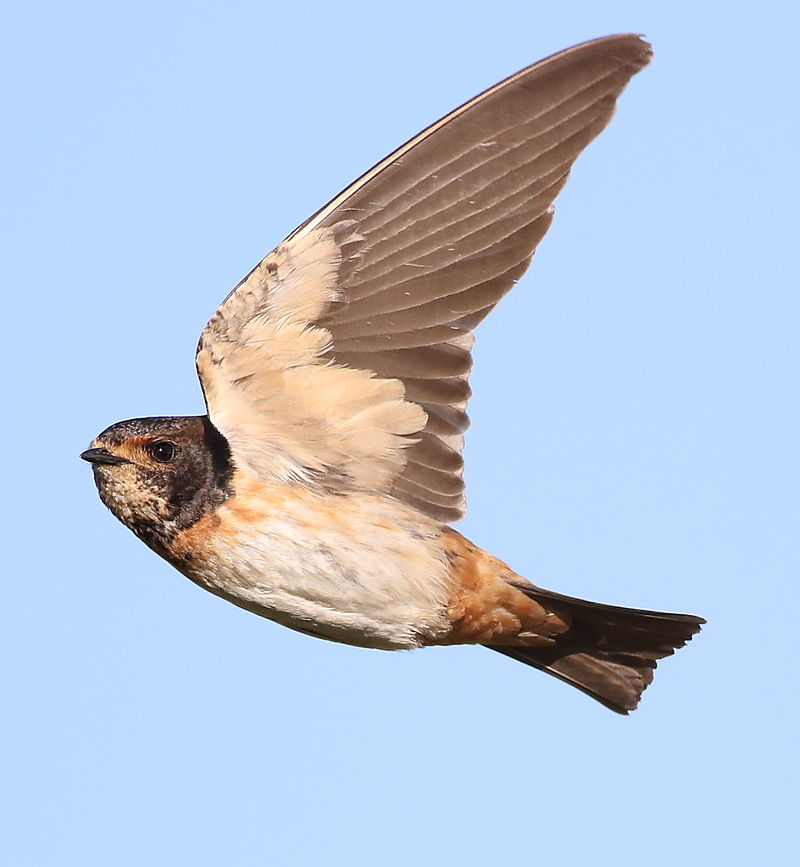
The South African cliff swallow is a species of bird found in central−western and southern Africa. It has an unmistakable plumage, consisting of glossy blue-black above with rufous on the throat and chest.
Its habitat consists primarily of rocky cliffs where it builds its mud nests. This small migratory bird forages over open country or grassland near water bodies such as wetlands, rivers and lakes.
During breeding season they form large colonies which have been known to contain up to 50,000 individuals.
The South African cliff swallow plays an important role in insect control while also providing food sources for predators like eagles and hawks.
Overall this unique species provides us with plenty of entertainment when we get the chance to observe them flying around their natural habitats.Scientific classification:
| Kingdom | Animalia |
| Phylum | Chordata |
| Class | Aves |
| Order | Passeriformes |
| Family | Hirundinidae |
| Genus | Petrochelidon |
| Species | P. spilodera |
28. Eurasian Crag Martin
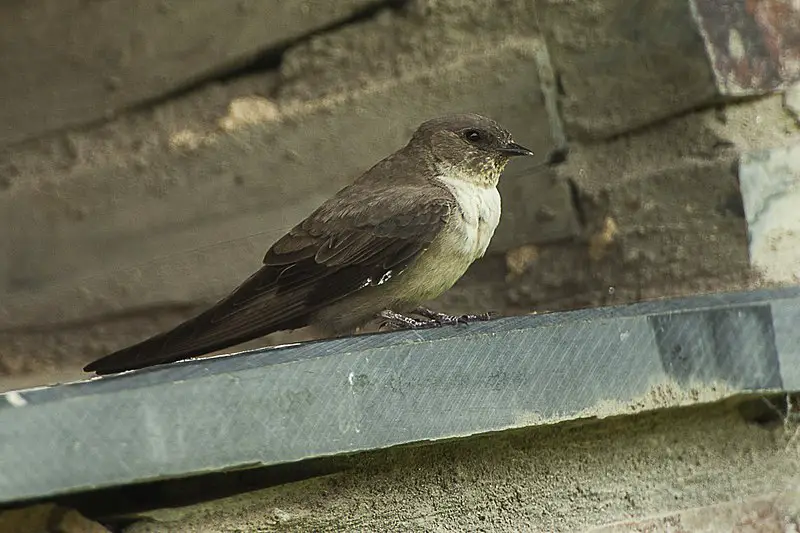
The Eurasian crag martin is a small passerine bird in the swallow family, measuring 14 cm long.
It boasts ash-brown upperparts and paler underparts, with a short square tail featuring white patches on most of its feathers.
This species breeds in southern Europe, northwestern Africa and across the Palearctic region.
Though similar looking to other martins such as Alpine or Rock Martins, it can be distinguished by the less extensive dark markings on its neck and throat area that lack any brownish tinge.
Crag Martin’s diet consists mainly of insects which are caught while flying low over open areas near rocks or cliffs – hence their name.Scientific classification:
| Kingdom | Animalia |
| Phylum | Chordata |
| Class | Aves |
| Order | Passeriformes |
| Family | Hirundinidae |
| Genus | Ptyonoprogne |
| Species | P. rupestris |
29. Square-Tailed Saw-Wing
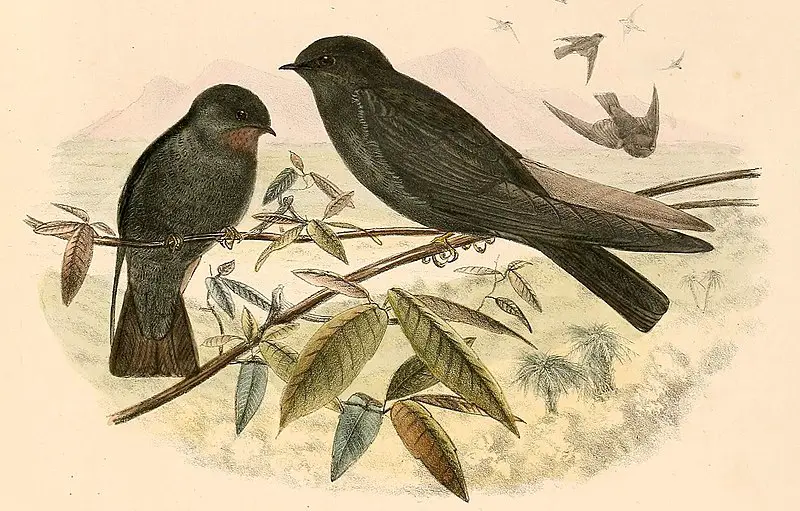
The Square-tailed Saw-wing is a species of bird belonging to the family Hirundinidae. It can be found in Angola, Cameroon, Central African Republic, Congo (both Republic and Democratic), Ivory Coast, Equatorial Guinea, Gabon, Ghana, Guinea ,Liberia Nigeria and Sierra Leone.
This small swallow has two recognised subspecies – P. n. nitens which is mainly found in West Africa while P. n. emini prefers East Africa as its home base.
It measures between 13–15 cm with a wingspan ranging from 28–30 cm long The upperparts are glossy blue black with white under parts that have grayish streaks on flanks.
This little avian beauty has bold square tail when viewed from above making it easily identifiable among other swallows.
Its diet consists of flying insects such as flies and termites which they catch midair by swooping down or hovering gracefully over water bodies hunting for food.Scientific classification:
| Kingdom | Animalia |
| Phylum | Chordata |
| Class | Aves |
| Order | Passeriformes |
| Family | Hirundinidae |
| Genus | Psalidoprocne |
| Species | P. nitens |
30. Grey-Rumped Swallow
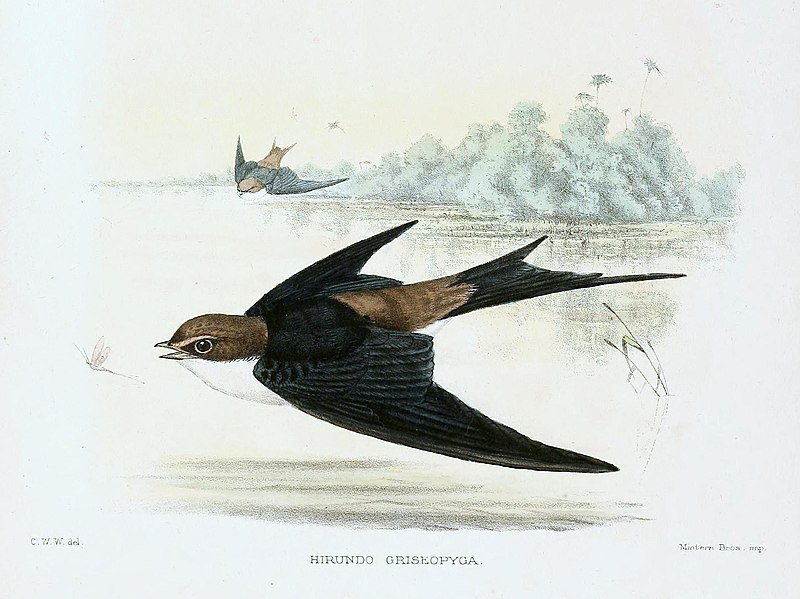
The Grey-rumped Swallow is a stunning species of swallow found in many African countries. This medium-sized bird has grey plumage, white throat and an orange rump which gives the bird its name.
It feeds on insects by flying close to water bodies or over open fields; it also builds cup nests often near human settlements such as villages and farms.
Its range includes Angola, Benin, Botswana, Burkina Faso, Burundi and other African nations from Cameroon to Gambia.
Although primarily insectivorous this swallow may occasionally eat fruits like figs too. The population size of this species is decreasing due mainly habitat loss caused by deforestation activities that destroy their nesting sites.
Conservation efforts are needed to ensure that these beautiful birds will continue to thrive throughout Africa for generations to come.Scientific classification:
| Kingdom | Animalia |
| Phylum | Chordata |
| Class | Aves |
| Order | Passeriformes |
| Family | Hirundinidae |
| Genus | Pseudhirundo Roberts, 1922 |
| Species | P. griseopyga |
31. Pale-Footed Swallow
The Pale-footed Swallow is a small bird belonging to the Hirundinidae family, native to the northern Andes from Venezuela to Bolivia.
It’s monotypic and found in subtropical or tropical moist montane forests, where it typically moves around in flocks with other birds of its species as well as blue-and-white swallows.
These birds have been classified by the International Union for Conservation of Nature (IUCN) as being least concern due their stable population numbers across most locations they inhabit.
They are usually viewed feeding on insects while flying above tree canopies before returning back down again and nesting within crevices located within rock faces near rivers or streams.Scientific classification:
| Kingdom | Animalia |
| Phylum | Chordata |
| Class | Aves |
| Order | Passeriformes |
| Family | Hirundinidae |
| Genus | Orochelidon |
| Species | O. flavipes |
32. White-Banded Swallow
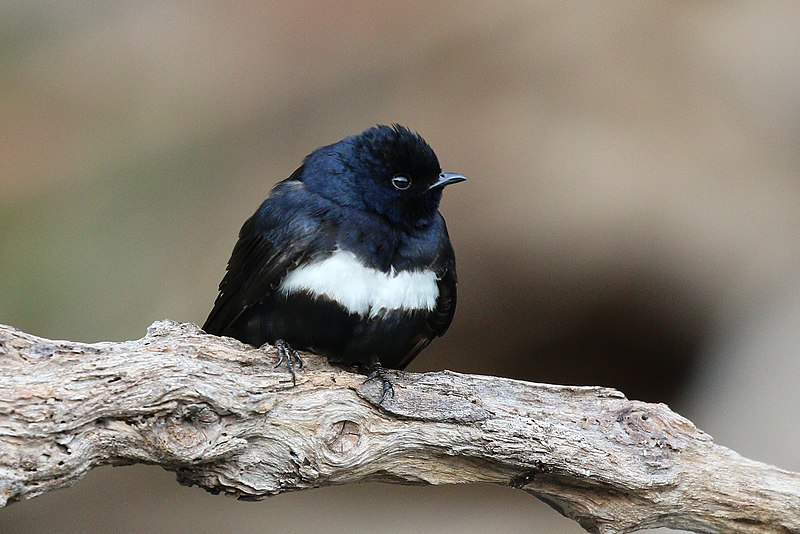
The White-banded Swallow is a beautiful and unique species of bird found in tropical South American countries. It has striking black plumage adorned with white thighs, breast and wing bars, as well as a deeply forked tail.
This non-migratory bird prefers to make its home in lowland areas such as rainforests or wet savannahs where it can find plenty of insects on which to feed.
Conservation efforts are underway due to this swallow’s declining population numbers caused by the destruction of their natural habitats, mainly from deforestation activities.
With proper management and protection these birds can continue to thrive amongst us.Scientific classification:
| Kingdom | Animalia |
| Phylum | Chordata |
| Class | Aves |
| Order | Passeriformes |
| Family | Hirundinidae |
| Genus | Atticora |
| Species | A. fasciata |
33. Brown-Chested Martin
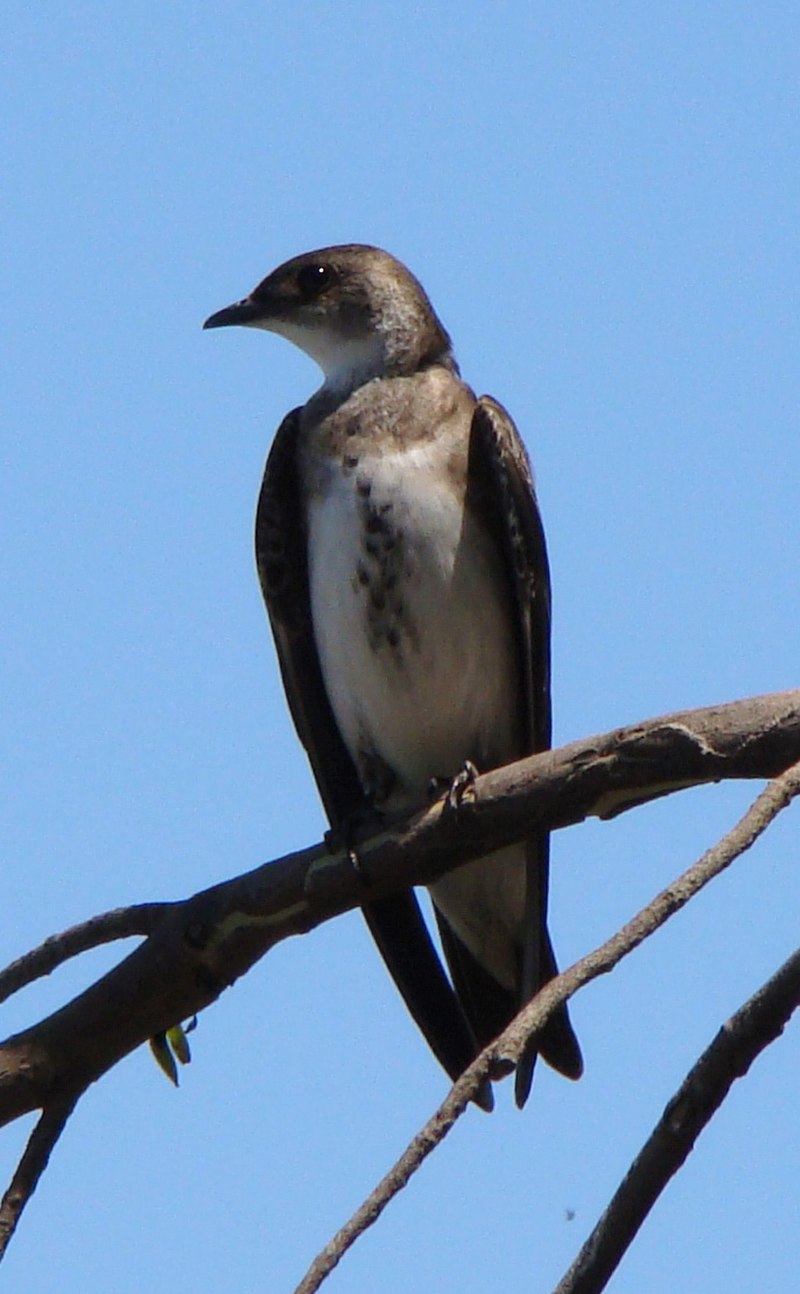
The Brown-chested Martin is a beautiful species of passerine bird, belonging to the swallow family.
It can be found throughout South America and even in parts of North America such as Puerto Rico and the United States.
These birds have an affinity for dry savannas or subtropical or tropical climates. The male has a chestnut brown breast while the female’s is greyish brown with dark streaks running through it along with white underparts.
They are known to feed mainly on insects which they catch mid-flight, making them quite agile fliers.
With their bold colors and acrobatic flying skills, these lovely little birds often put on impressive displays that can captivate any onlooker.Scientific classification:
| Kingdom | Animalia |
| Phylum | Chordata |
| Class | Aves |
| Order | Passeriformes |
| Family | Hirundinidae |
| Genus | Progne |
| Species | P. tapera |
34. Banded Martin
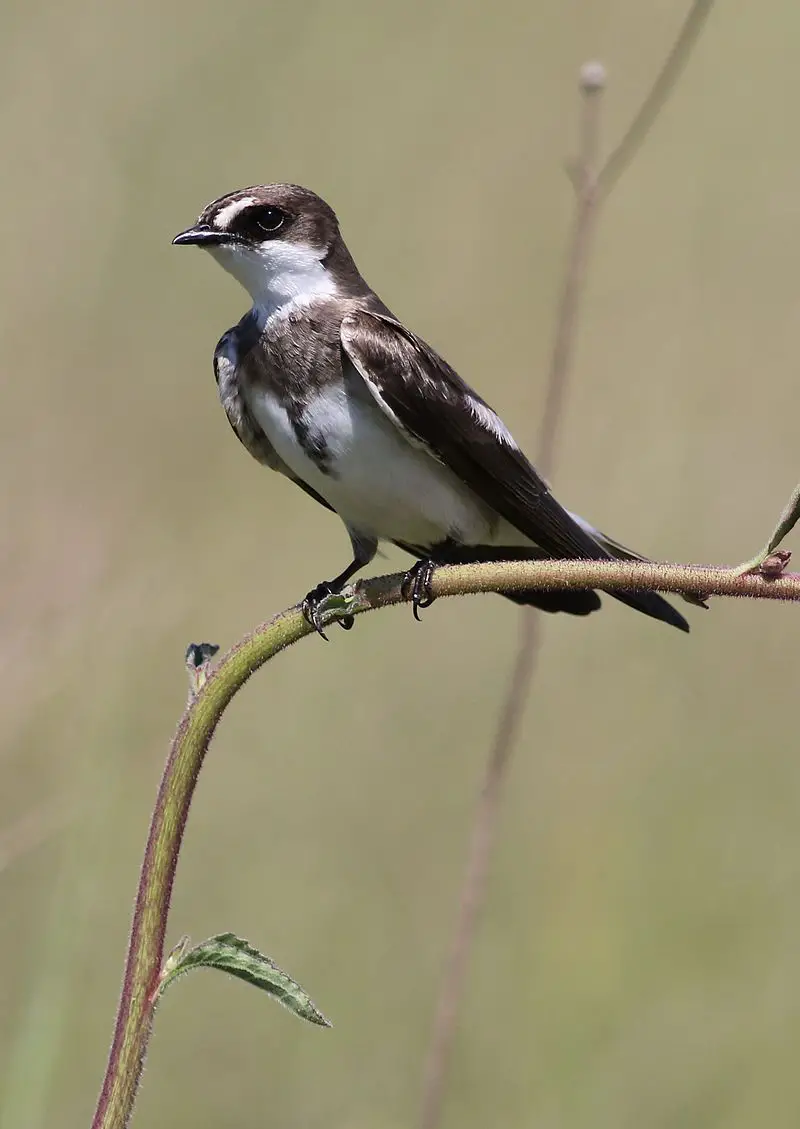
The Banded Martin is a small passerine bird that’s endemic to Africa and the only species of its genus Neophedina.
It was first described by French polymath Georges-Louis Leclerc in 1780 from a specimen collected at Cape of Good Hope.
This migratory bird has brownish upperparts, white throat with black stripes, grey underparts and tail feathers which are dark grey on top and pale underneath.
These birds feed mainly on flying insects like termites during flight, or sometimes they may catch prey while hovering over water surfaces before diving in for their food.
They can be seen near lakes or rivers where these birds breed in colonies between August – September making mud nests close to each other inside reeds beds or beneath rocks.Scientific classification:
| Kingdom | Animalia |
| Phylum | Chordata |
| Class | Aves |
| Order | Passeriformes |
| Family | Hirundinidae |
| Genus | Neophedina Roberts, 1922 |
| Species | N. cincta |
35. Southern Rough-Winged Swallow
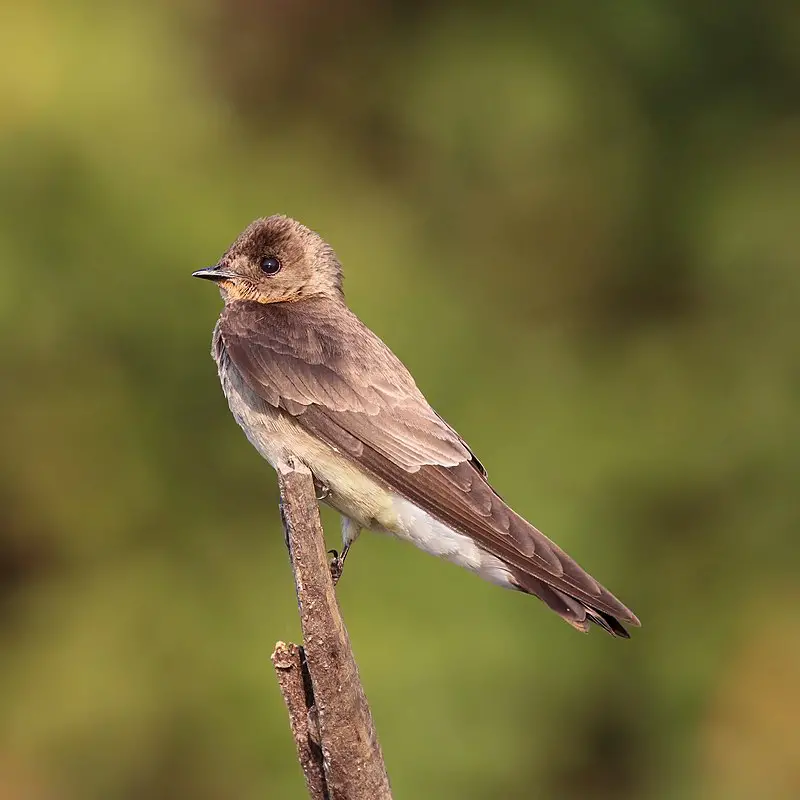
The Southern rough-winged swallow is a small brown bird with blackish wings and tail. It has a pale grey rump, and white chin, throat and upper breast.
This species was first described by French ornithologist Louis Vieillot in 1817, measuring 13.5 cm in length while weighing 15 g on average.
These birds are often seen catching insects over open fields or wet meadows during the summer months before migrating to warmer climates for wintertime breeding season.
Their nests can be found beneath bridges or other human structures such as cliffs and buildings – usually near water sources like rivers or lakeside creeks – where they use mud pellets to build their cup shaped homes lined with feathers for insulation against cold weather temperatures .Scientific classification:
| Kingdom | Animalia |
| Phylum | Chordata |
| Class | Aves |
| Order | Passeriformes |
| Family | Hirundinidae |
| Genus | Stelgidopteryx |
| Species | S. ruficollis |
36. Black-Collared Swallow
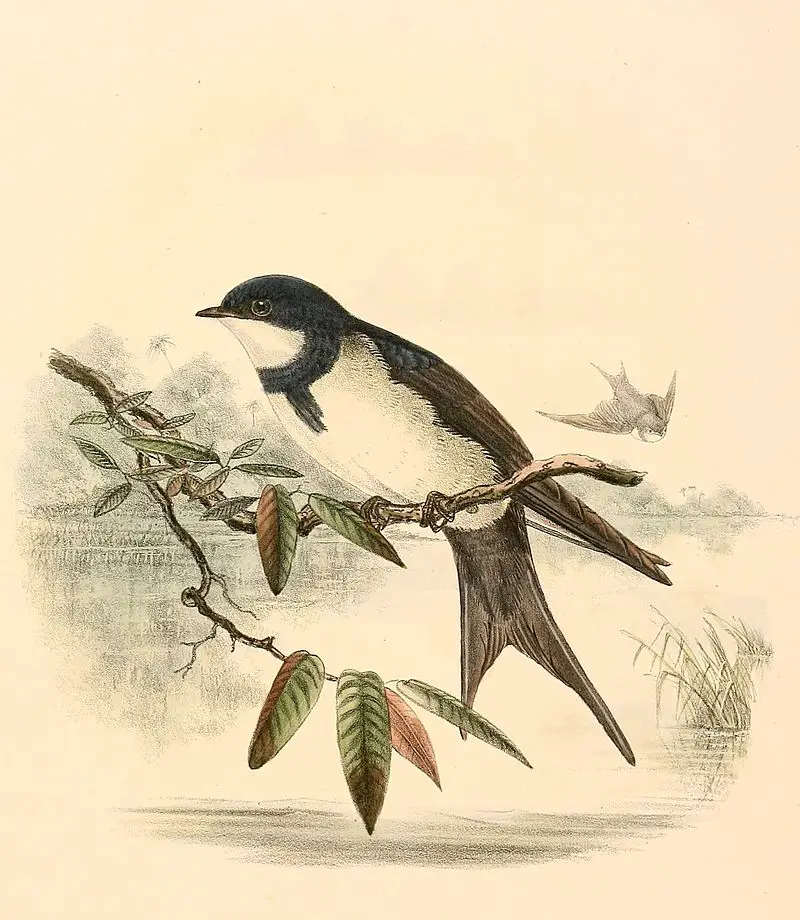
The black-collared swallow is a species of bird that can be found in South America, mainly around rivers.
It has been classified as part of the Hirundinidae family and was previously placed in the genus Atticora until a 2005 phylogenetic study moved it to the resurrected Pygochelidon genus.
This small brownish or greyish colored bird grows up to 15 cm long with its wingspan reaching 23 cm wide.
Its tail is forked, giving them an elegant appearance while flying through their natural habitat – rivers – looking after food such as insects which they scoop out from mid air during flight.
These birds are social animals often forming large flocks when searching for food or migrating together; making them quite visible on a beautiful summer day.Scientific classification:
| Kingdom | Animalia |
| Phylum | Chordata |
| Class | Aves |
| Order | Passeriformes |
| Family | Hirundinidae |
| Genus | Pygochelidon |
| Species | P. melanoleuca |
37. Swallow-Tailed Kite
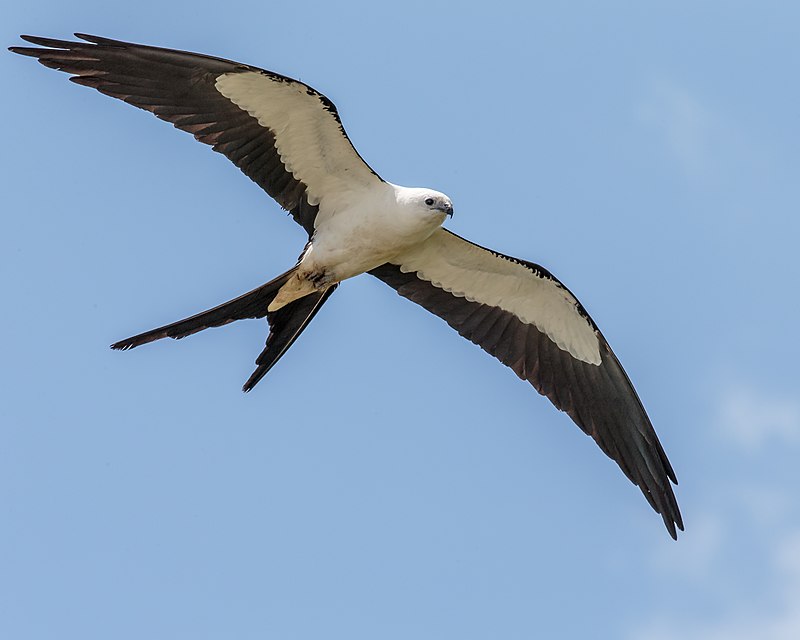
The Swallow-tailed Kite is a beautiful bird found in the southeastern United States, all the way to eastern Peru and northern Argentina.
It’s only species of its genus, Elanoides forficatus, and it has a characteristic swallow tail shape that makes it easily recognizable.
During breeding season North and Central American breeders migrate south to spend winter with those who are resident year round.
First described as “swallow-tail hawk” or “accipiter cau,” this majestic raptor soars through skies with ease – often gliding on updrafts without even flapping their wings.
With its unique silhouette they truly stand out against any landscape making them one of nature’s most remarkable sights.Scientific classification:
| Kingdom | Animalia |
| Phylum | Chordata |
| Class | Aves |
| Order | Accipitriformes |
| Family | Accipitridae |
| Genus | Elanoides Vieillot, 1818 |
| Species | E. forficatus |
Also Featured In: Birds You Should Know San Marco Island,
38. Wire-Tailed Swallow
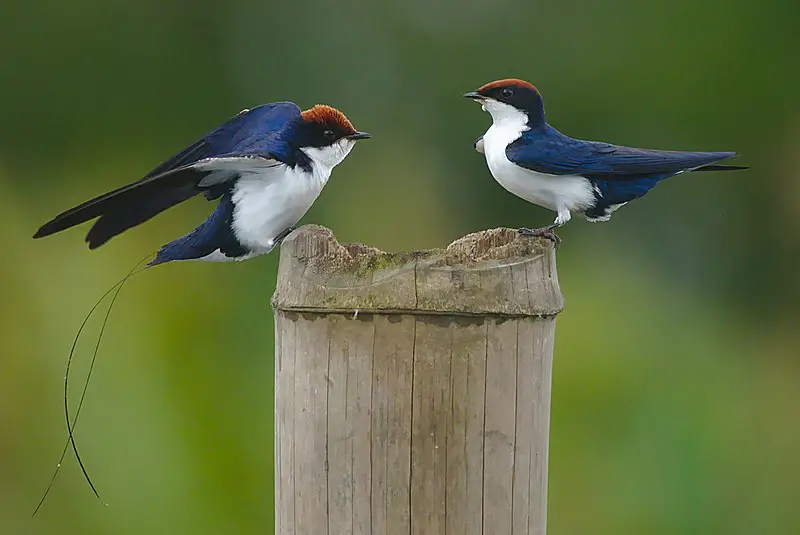
The Wire-tailed Swallow is a small passerine bird from the Hirundo genus and swallow family.
It has two subspecies, one of which can be found in Africa (Hirundo smithii) and the other in Southern and South Eastern Asia (Hirundo filifera).
The species is mainly resident but populations located at Pakistan and Northern India migrate further south during winter season.
These birds are characterized by their brownish back feathers with white spots along with rufous underparts.
Their distinctive feature being long outer tail feathers that extend beyond even their wingspan when seen while they’re flying.Scientific classification:
| Kingdom | Animalia |
| Phylum | Chordata |
| Class | Aves |
| Order | Passeriformes |
| Family | Hirundinidae |
| Genus | Hirundo |
| Species | H. smithii |
Also Featured In: Birds that Live in Rajasthan, Delhi Birds You Need to See
39. White-Throated Swallow
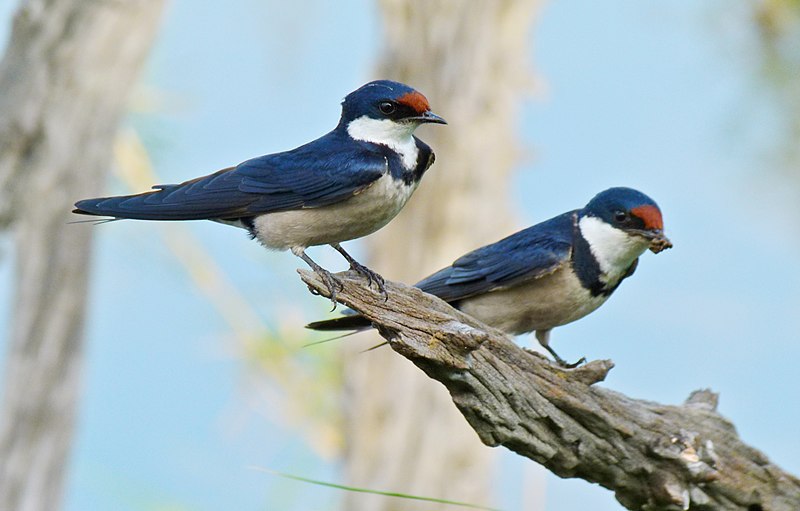
The White-throated Swallow is a small bird of the swallow family found widely in Southern Africa. It has glossy dark blue upperparts, with a bright chestnut crown and separating it from its white throat.
At around 14–17 cm long, these birds have benefited tremendously from manmade structures such as dams and bridges providing them suitable nesting sites for colonies.
They are often seen swooping through open spaces looking to feed on flying insects in swarms or perched atop telephone wires keeping an eye out for prey below.
Their call consists of short metallic chirps that can be heard even at great distances away during their migratory season when they move southwards to find safer grounds before winter sets in.Scientific classification:
| Kingdom | Animalia |
| Phylum | Chordata |
| Class | Aves |
| Order | Passeriformes |
| Family | Hirundinidae |
| Genus | Hirundo |
| Species | H. albigularis |
40. Ethiopian Swallow
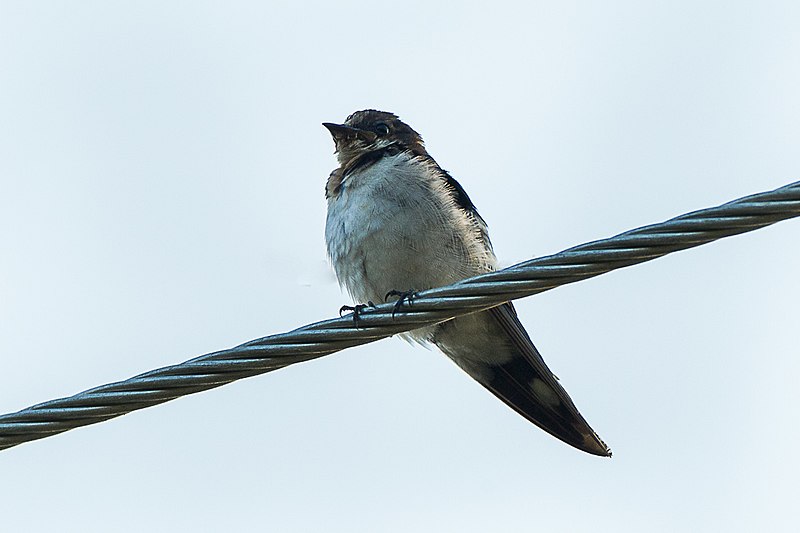
The Ethiopian swallow is an impressive species of bird belonging to the Hirundinidae family.
With a wide range extending from Benin through Ethiopia, Eritrea, Somalia and Sudan all the way down to Togo in West Africa, these birds are found across vast swathes of this continent.
They’re non-migratory but can be seen fluttering around open areas with plenty of vegetation such as savanna grasslands or agricultural fields.
Their diet consists mainly on insects they catch while in flight – making them beneficial for controlling pest populations.
These swallows have also adapted well to living among humans and can often be spotted nesting close by buildings or other manmade structures.
With their unique black plumage marked by flashes of white along its wings and tail feathers, it’s easy to recognize the beauty that is The Ethiopian Swallow.Scientific classification:
| Kingdom | Animalia |
| Phylum | Chordata |
| Class | Aves |
| Order | Passeriformes |
| Family | Hirundinidae |
| Genus | Hirundo |
| Species | H. aethiopica |
41. Preuss’s Cliff Swallow

The Preuss’s cliff swallow is a species of bird that mainly inhabits the western parts of Africa.
It belongs to the family Hirundinidae and can be found in countries like Benin, Burkina Faso, Cameroon, Central African Republic, Chad, Congo and other nations.
They are small birds with long tails forked at their tips which help them maneuver easily when flying.
Their wingspan averages 18 cm while their bodies range from 12–14 cm in length; they have brownish-grey upperparts and white underparts with some grey on its chest area.
These swallows make nests out of mud pellets that they fashion into cup-shaped structures attached to vertical surfaces near water sources or cliffs hence its name “cliff swallow”.
They feed mainly insects as well as spiders occasionally making it an important part of local ecosystems by helping control insect populations.Scientific classification:
| Kingdom | Animalia |
| Phylum | Chordata |
| Class | Aves |
| Order | Passeriformes |
| Family | Hirundinidae |
| Genus | Petrochelidon |
| Species | P. preussi |
42. Fanti Saw-Wing
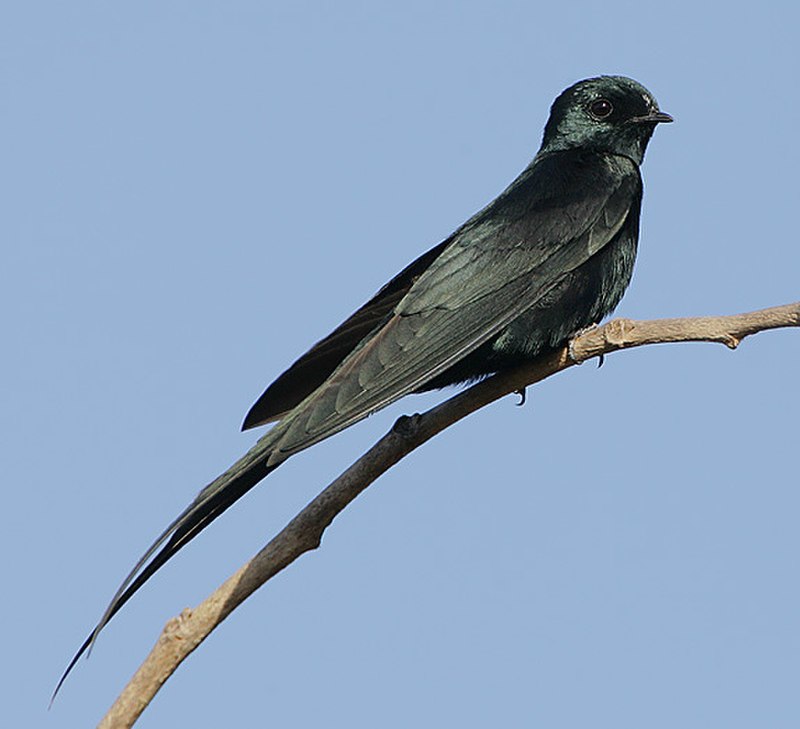
The Fanti saw-wing is a stunningly beautiful bird, with its whole body covered in shimmering green feathers. It has a long and deeply forked tail which adds to its grace when it takes flight.
Males and females look alike though the female’s plumage may be slightly duller than that of the male.
The species stands at 17cm tall and can typically be found perched on telephone lines or hovering over still bodies of water looking for food such as insects, larvae and small fish.
Its diet also includes spiders, frogs, earthworms, fruits and berries from nearby trees. This swallow is an agile flyer who will often hunt in pairs or groups depending on where they’re located geographically – usually their migration paths determine this behaviour.
They have adapted well to human habitat but prefer open cleared areas close to streams or rivers where there are plenty of flying insects available for them to feed uponScientific classification:
| Kingdom | Animalia |
| Phylum | Chordata |
| Class | Aves |
| Order | Passeriformes |
| Family | Hirundinidae |
| Genus | Psalidoprocne |
| Species | P. obscura |
43. Chilean Swallow
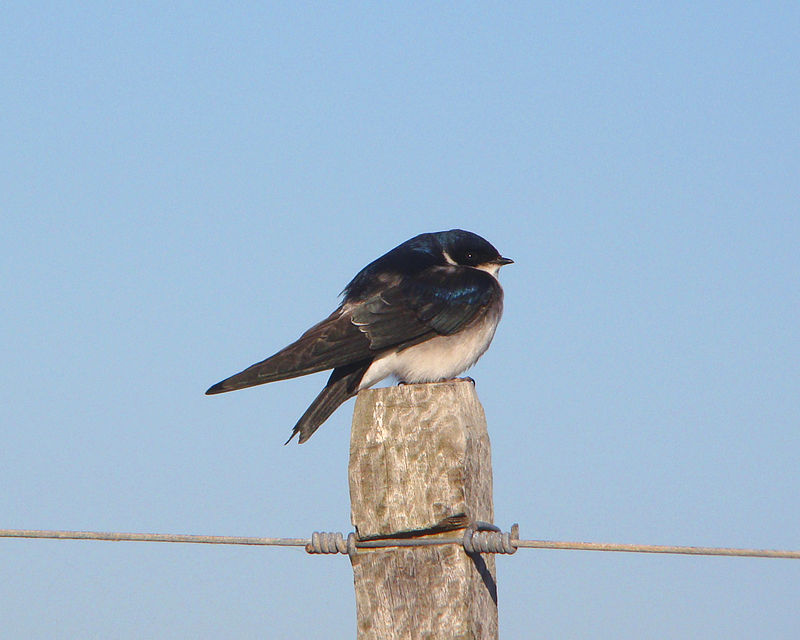
The Chilean swallow is a species of bird in the family Hirundinidae, which breeds mainly in Chile and Patagonia. It migrates northwards to Bolivia, Paraguay and Rio Grande do Sul during certain times of year.
The genus Tachycineta was created for this group by Jean Cabanis in 1850; its name originated from Ancient Greek takhukinetos meaning “moving quickly”.
This fast-flying swallow has white underparts with blue upperparts on both males and females.
Its tail is deeply forked with glossy black feathers at the tip while its bill is blackish-grey above but pale below.
During breeding season they may form large colonies near rivers or streams where they build cup shaped nests made out of mud pellets lined with grasses or hair found nearby their chosen nesting site.Scientific classification:
| Kingdom | Animalia |
| Phylum | Chordata |
| Class | Aves |
| Order | Passeriformes |
| Family | Hirundinidae |
| Genus | Tachycineta |
| Species | T. leucopyga |
Also Featured In: Common Birds that Live around Ushuaia,
44. Red-Rumped Swallow
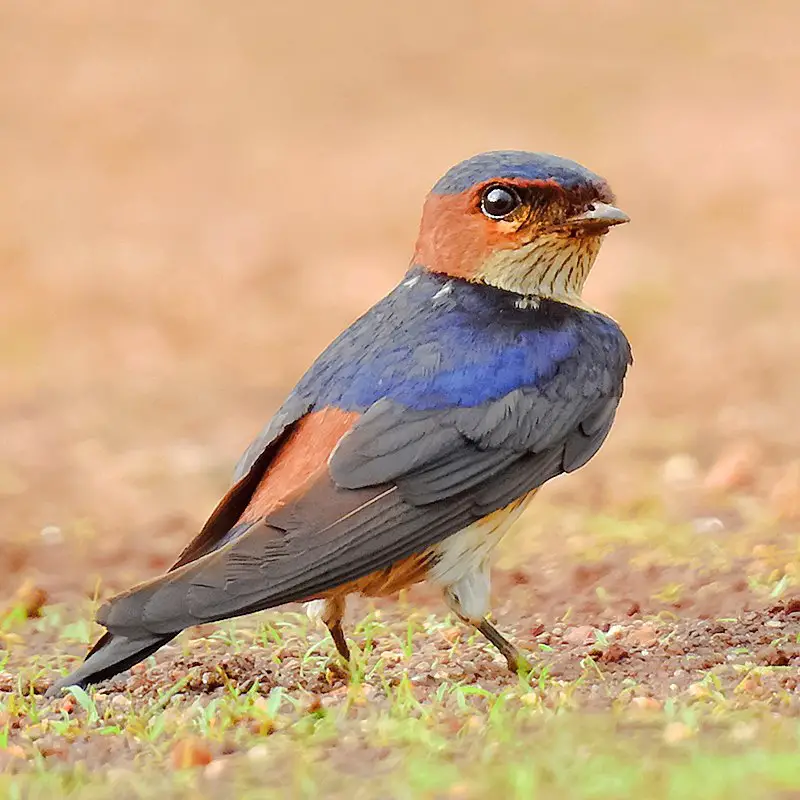
The Red-rumped Swallow is a beautiful bird of the swallow family that can be found in temperate southern Europe and Asia all the way from Portugal to Japan.
It breeds in open hilly country, while Indian and African birds are resident year round; however, European and other Asian swallows migrate south for winter to Africa or India.
These graceful creatures have even been observed as vagrants on Christmas Island. These small passerine birds are known for their striking red rumps which contrast against their otherwise dark blue plumage.
The diet of these swallows consist primarily of insects such as flies, bees, wasps etc., which they catch during short flights close to ground level.
So if you ever find yourself out in an open field near some hills this summer keep your eyes peeled for one of nature’s most stunning avian beauties -the Red-rumped Swallow.Scientific classification:
| Kingdom | Animalia |
| Phylum | Chordata |
| Class | Aves |
| Order | Passeriformes |
| Family | Hirundinidae |
| Genus | Cecropis |
| Species | C. daurica |
Also Featured In: Birds Live in Tunisia, Birds You’ll Find in Albania
45. Angola Swallow
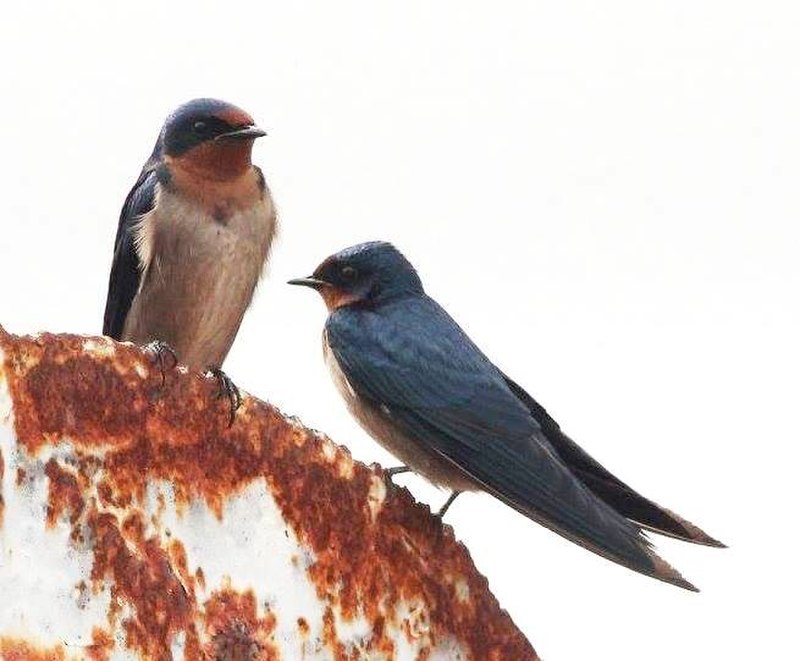
The Angola swallow is a beautiful species of bird native to the Afrotropics. Measuring 15cm and weighing 16-19g, it stands out with its deep rufous-chestnut forehead, throat and upper breast contrasted against a shiny steel-blue crown and upperparts.
The flight and tail feathers are black but have large white windows that give them an extra flash of colour in the sun.
They can be found in various open habitats up to 2200m above sea level; they like savanna grasslands or scrublands where there’s plenty of flying insects for food.
These agile birds fly high over fields when hunting, often coming together into flocks at dusk before settling down for the night.Scientific classification:
| Kingdom | Animalia |
| Phylum | Chordata |
| Class | Aves |
| Order | Passeriformes |
| Family | Hirundinidae |
| Genus | Hirundo |
| Species | H. angolensis |
46. White-Rumped Swallow
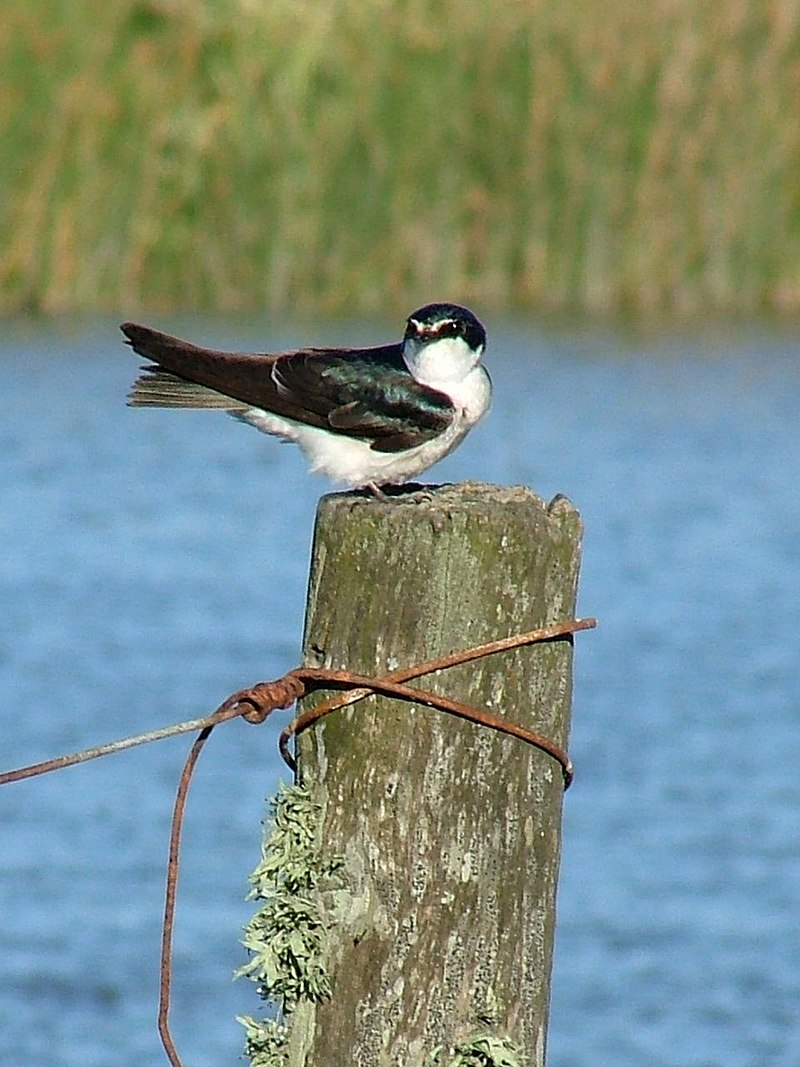
The White-rumped Swallow is a species of bird belonging to the family Hirundinidae. Native to South America, it was first described and given its binomial name by French ornithologist Louis Vieillot in 1817.
It has a distinctive white supraloral streak above its lores (region between eyes and bill). T
he swallow typically migrates from northern Argentina up through Peru, Ecuador and Colombia before settling in Central American countries like Mexico or Guatemala during winter months.
The species is monotypic with no known population variations – making conservation efforts all the more important for this unique bird.Scientific classification:
| Kingdom | Animalia |
| Phylum | Chordata |
| Class | Aves |
| Order | Passeriformes |
| Family | Hirundinidae |
| Genus | Tachycineta |
| Species | T. leucorrhoa |
47. Pearl-Breasted Swallow
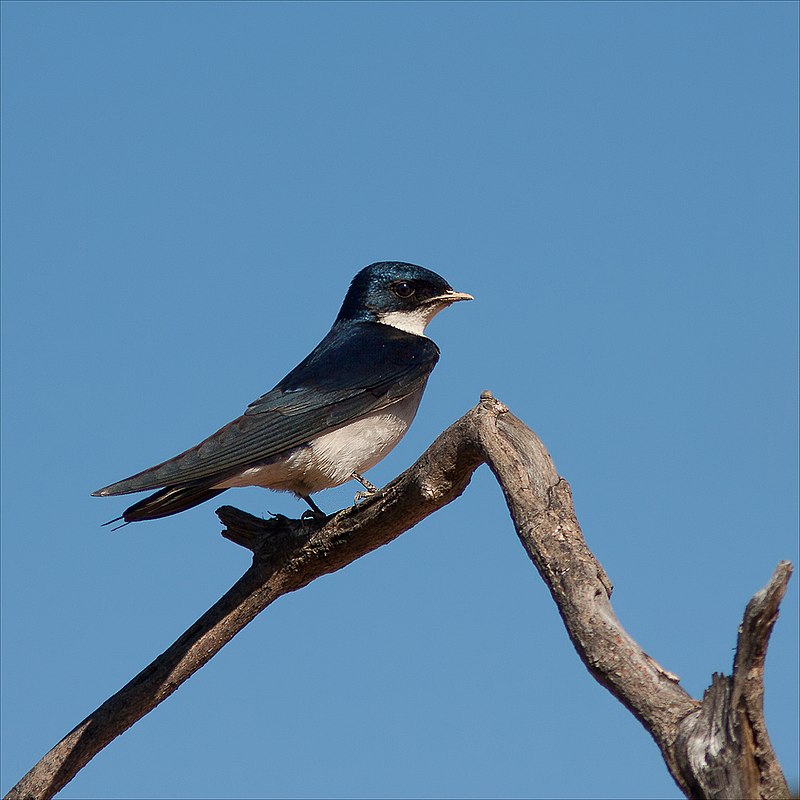
The Pearl-breasted Swallow is a small, beautiful bird. It has glossy blue upperparts and grey-white underparts which make it stand out from other Hirundo species since they usually have white in their tails.
The wings are blackish-blue and the underwing coverts a darker shade of grey-white.
Measuring 13 to 14 cm long, this swallow can often be seen flying through open woodlands or grassy areas near water sources such as rivers or lakes.
Its diet consists mainly of insects like flies, beetles and moths that it hunts midair for its sustenance.
An interesting feature about this species is the pearl breast which gives them their name – during breeding season males display an iridescent patch on their breasts with colours ranging from pink to purple.Scientific classification:
| Kingdom | Animalia |
| Phylum | Chordata |
| Class | Aves |
| Order | Passeriformes |
| Family | Hirundinidae |
| Genus | Hirundo |
| Species | H. dimidiata |
48. Bahama Swallow
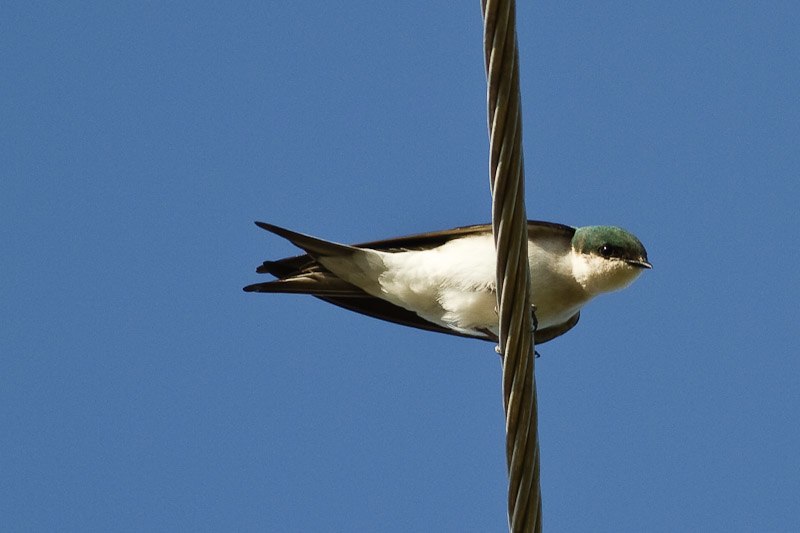
The Bahama swallow is a unique species of bird found only in the Bahamas. It has an emerald green head and back, blue wings, black tail and wingtips, and a white chin and belly.
This beautiful creature can be seen breeding mainly in pineyards on four islands – Andros, Grand Bahama, Abaco and New Providence.
The population on New Providence alone is estimated to number fewer than 250 individuals.
These swallows are generally solitary birds that feed during the day on insects such as flies or beetles.
They roost at night in shrubs or trees but rarely use artificial dwellings like barns or houses for shelter from predators.
Conservation efforts must be made to ensure this endemic species continues to thrive within its natural habitat range so future generations may appreciate its distinctive beauty too.Scientific classification:
| Kingdom | Animalia |
| Phylum | Chordata |
| Class | Aves |
| Order | Passeriformes |
| Family | Hirundinidae |
| Genus | Tachycineta |
| Species | T. cyaneoviridis |
49. Red-Throated Cliff Swallow
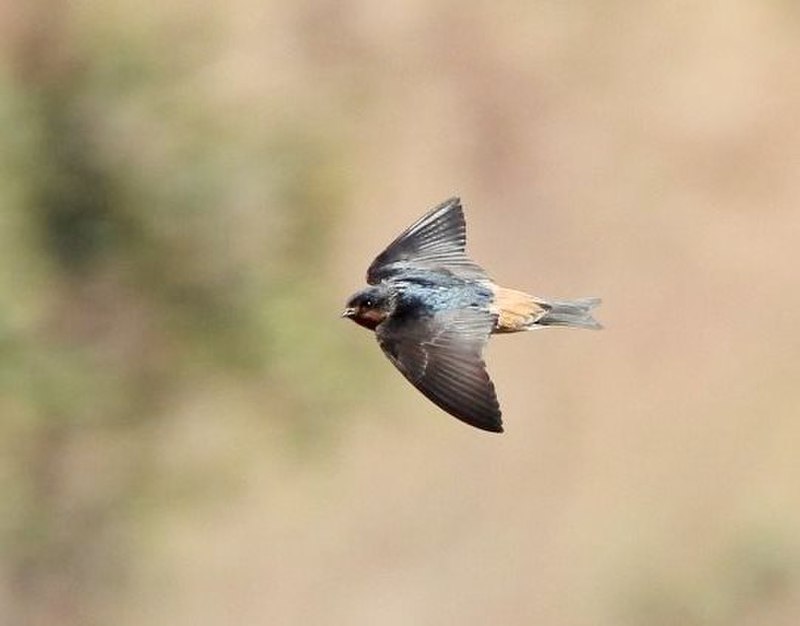
The Red-throated cliff swallow is a species of bird belonging to the family Hirundinidae. It can be found in Angola, Republic of Congo, DRC, Gabon and Zambia.
This small bird has red throat patches which distinguish them from other swallows. During breeding season they form colonies which collect mud pellets for nesting purposes.
In flight it moves with agility while occasionally turning on its back as well as hovering at times when searching for food or evading predators.
Red-throated Cliff Swallows feed mainly on insects like beetles and flies that are caught mid air whilst flying over pastures or open water surfaces such as lakes and rivers using their long pointed wings to manoeuvre quickly through the sky .Scientific classification:
| Kingdom | Animalia |
| Phylum | Chordata |
| Class | Aves |
| Order | Passeriformes |
| Family | Hirundinidae |
| Genus | Petrochelidon |
| Species | P. rufigula |
50. White-Winged Swallow
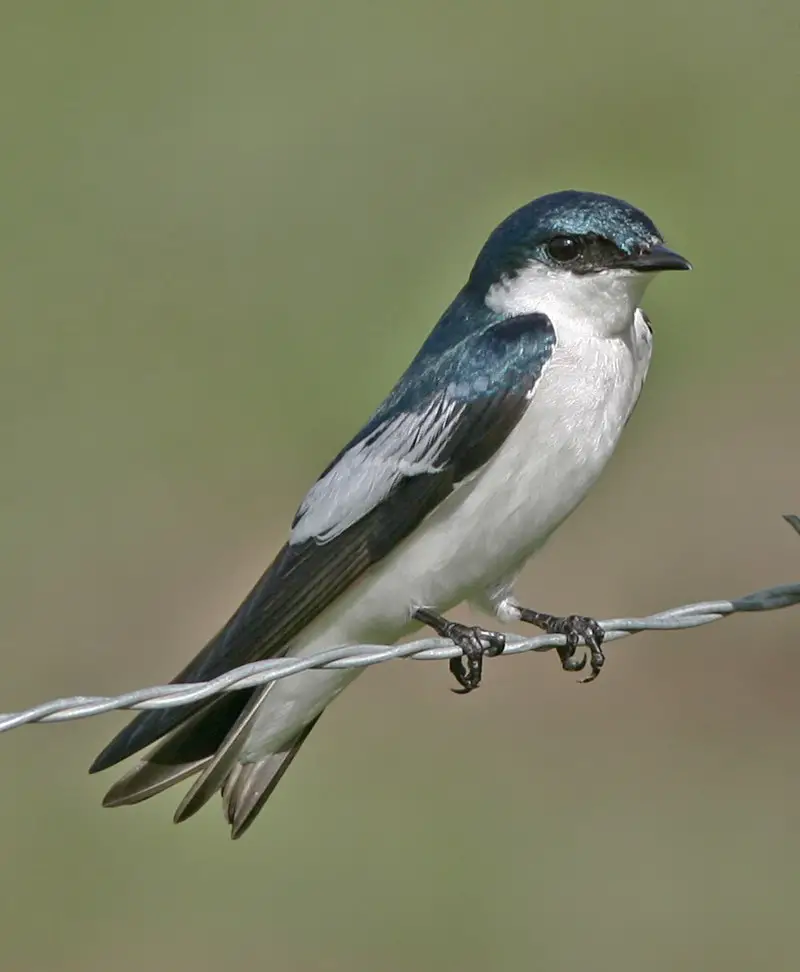
The White-winged Swallow is a small, brown bird with distinctive white patches on its wings and tail feathers. It can be found in tropical South America from Colombia to Argentina, but not west of the Andes.
These birds are mainly non-migratory and live in open habitats such as fields or grasslands.
The species was first described by Georges-Louis Leclerc in 1780 and they feed mostly on insects which they typically catch while flying low over water bodies or vegetation.
They build their nests near cliff faces where there is plenty of protection from predators such as hawks and owls.
With their beautiful plumage, these swallows make for interesting sights when spotted soaring gracefully through the air.Scientific classification:
| Kingdom | Animalia |
| Phylum | Chordata |
| Class | Aves |
| Order | Passeriformes |
| Family | Hirundinidae |
| Genus | Tachycineta |
| Species | T. albiventer |
51. White-Eyed River Martin
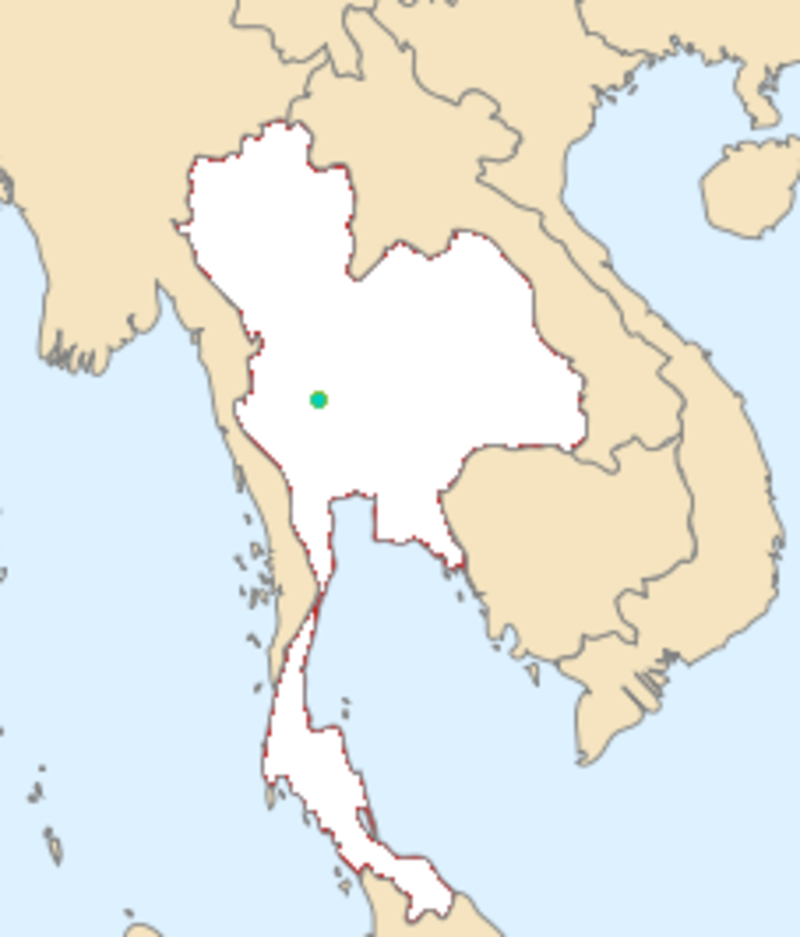
The white-eyed river martin is a rare species of swallow, only known to be found at a single wintering site in Thailand.
It was first discovered in 1968 and has significant differences from its closest relative, the African river martin.
These include its distinctively white eye color and unique tail shape that sets it apart from other swallows.
Its future remains uncertain as there have been no sightings since 1998 indicating that this species may already be extinct or critically endangered due to habitat destruction or overhunting for food by local people.
Conservation efforts are paramount if we want to save this beautiful bird before it is too late.Scientific classification:
| Kingdom | Animalia |
| Phylum | Chordata |
| Class | Aves |
| Order | Passeriformes |
| Family | Hirundinidae |
| Genus | Pseudochelidon |
| Species | P. sirintarae |